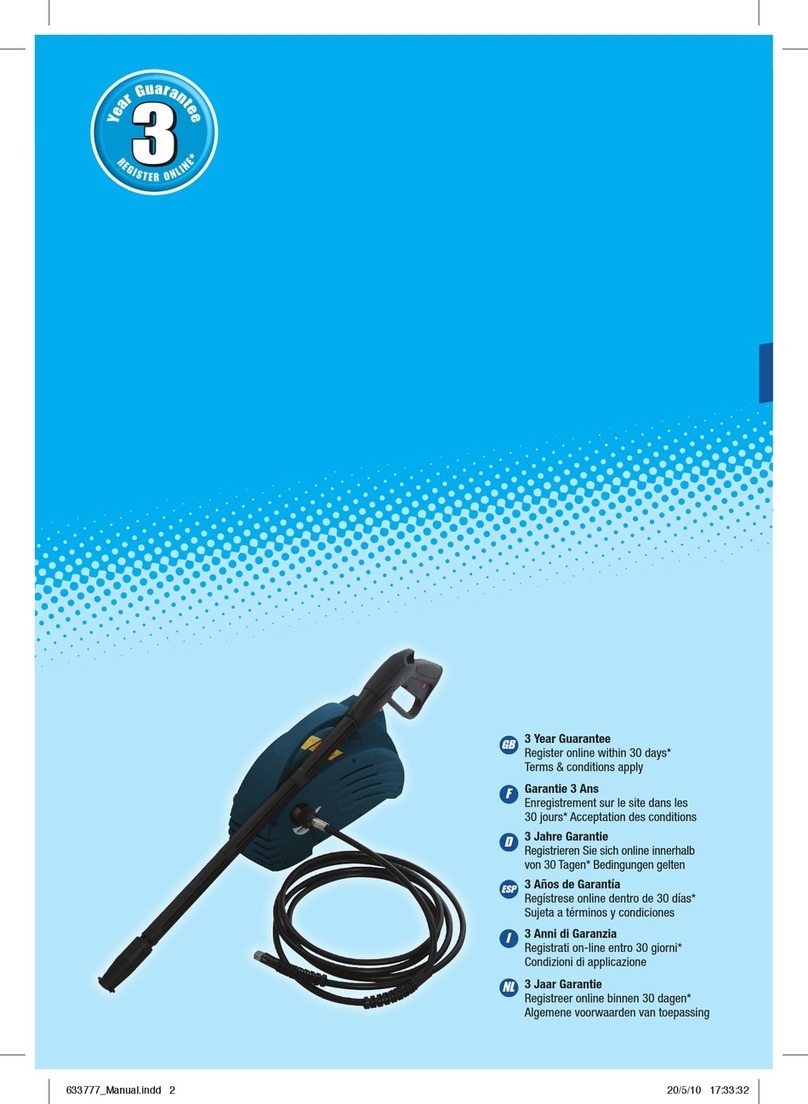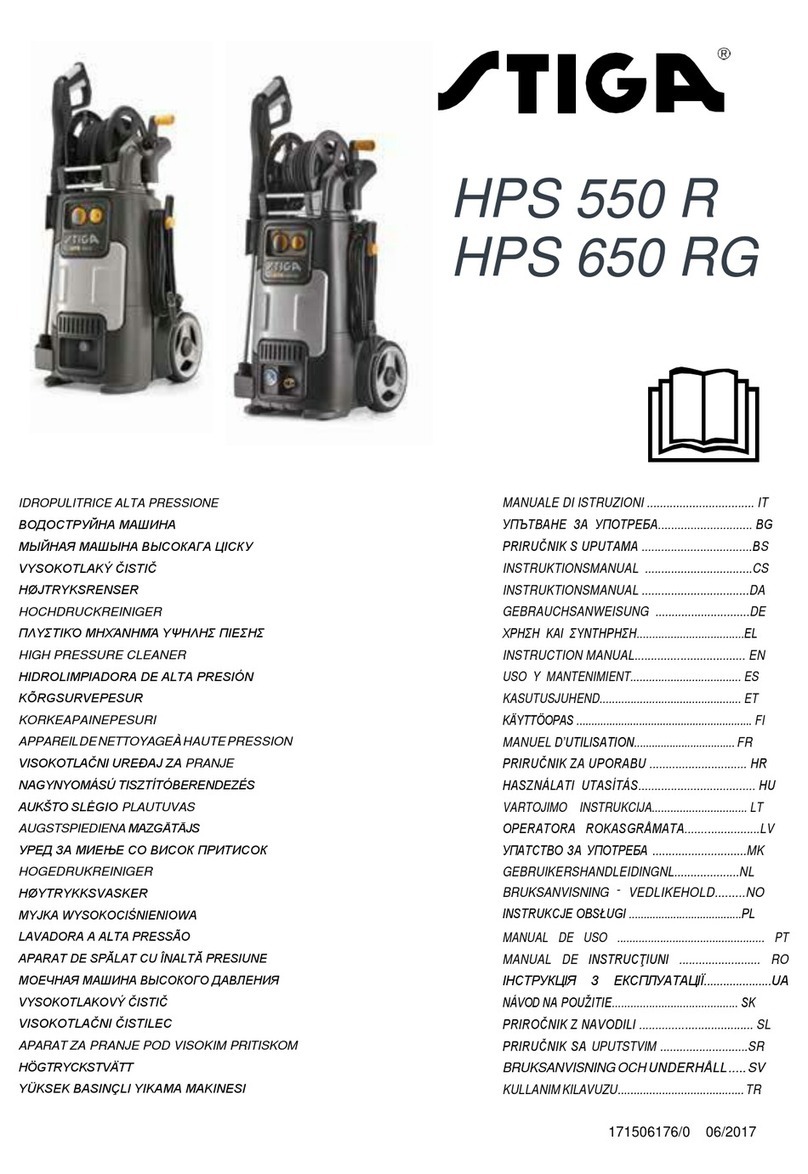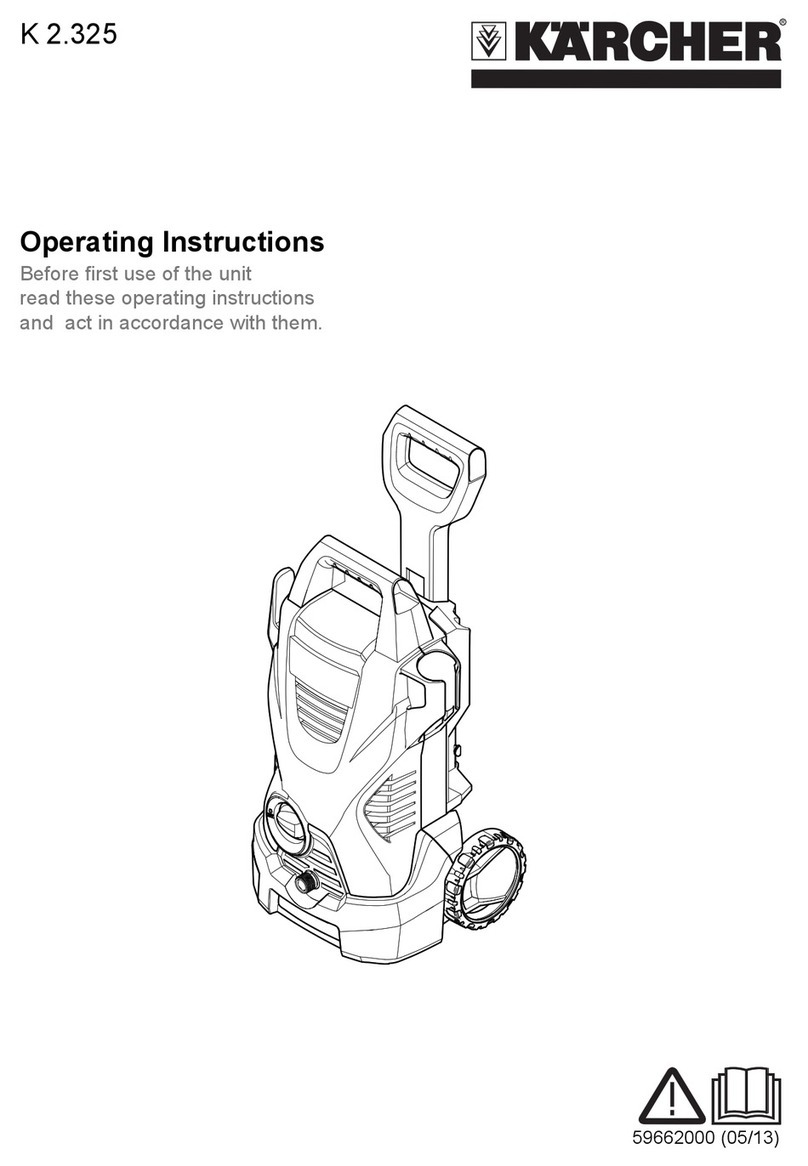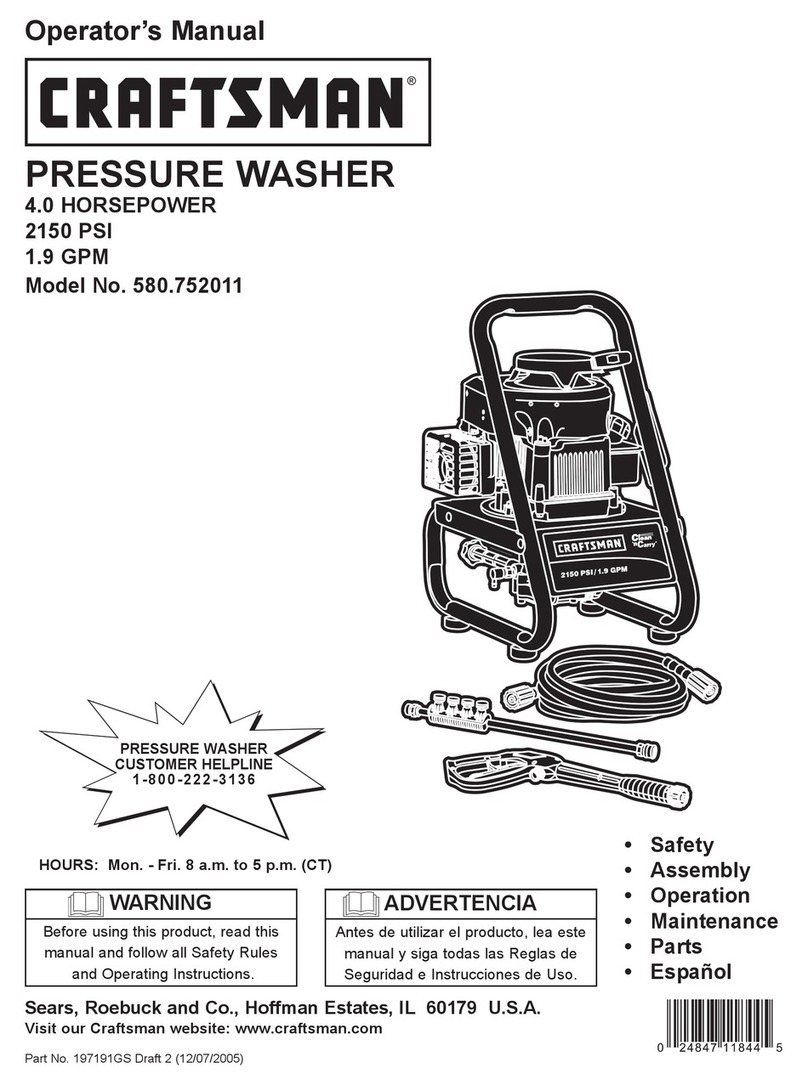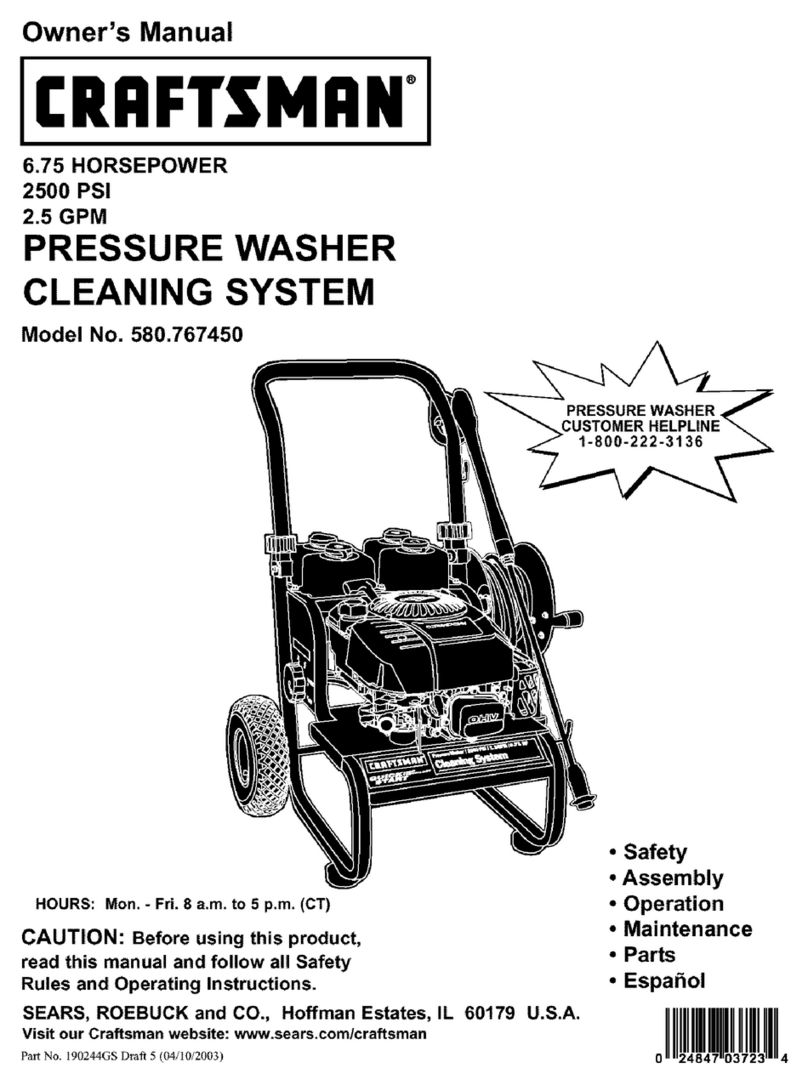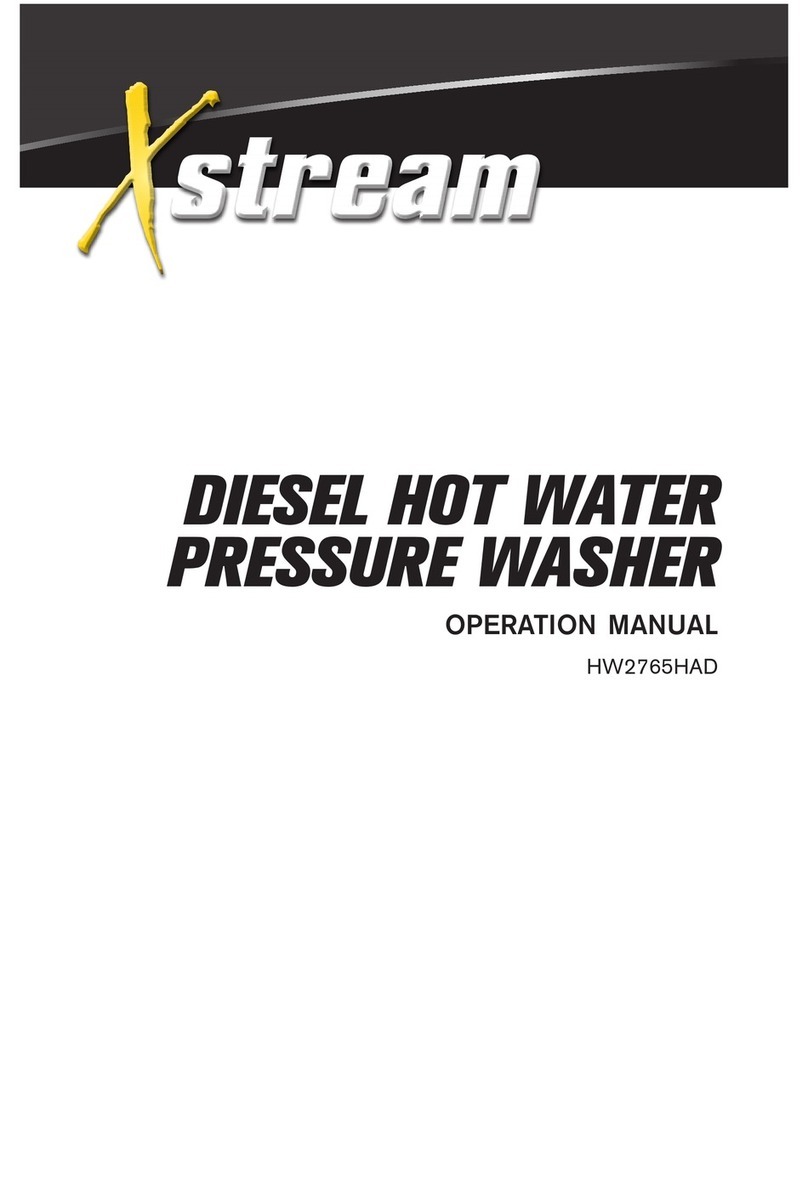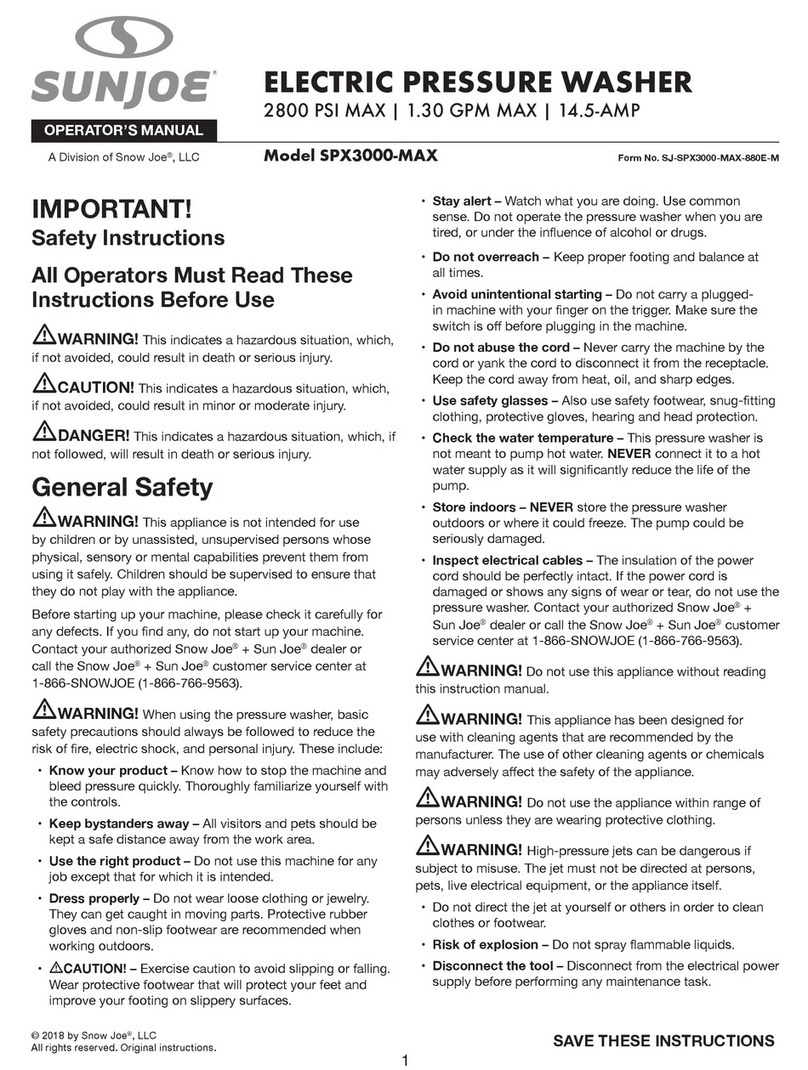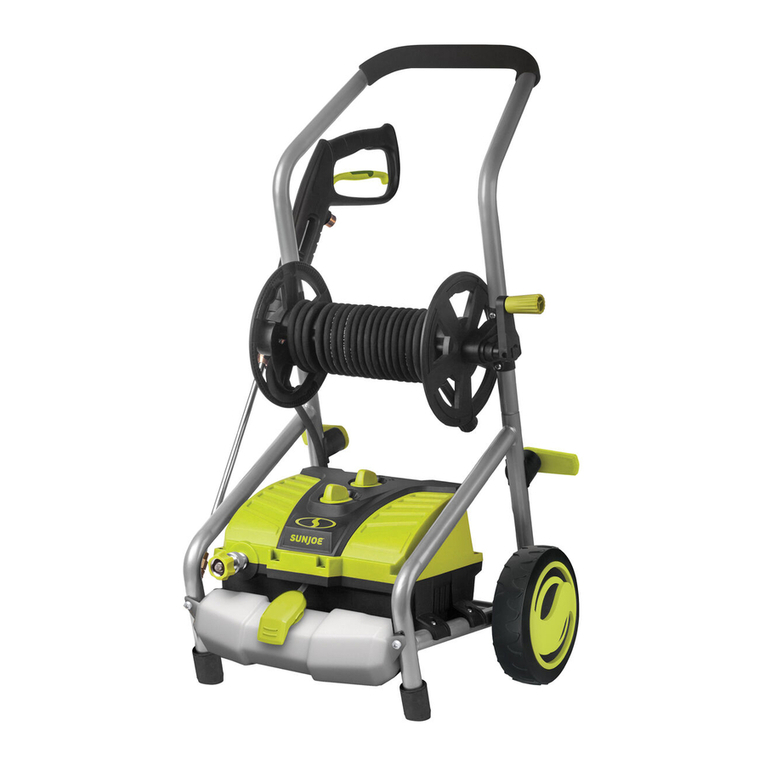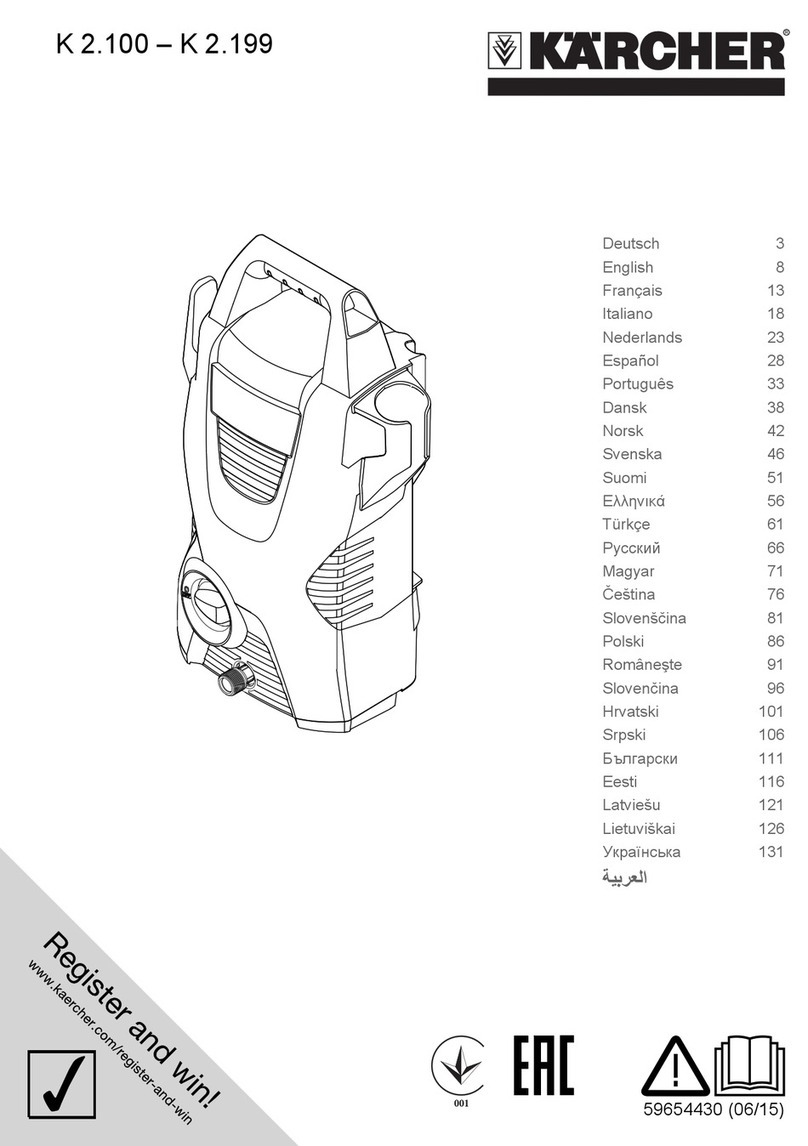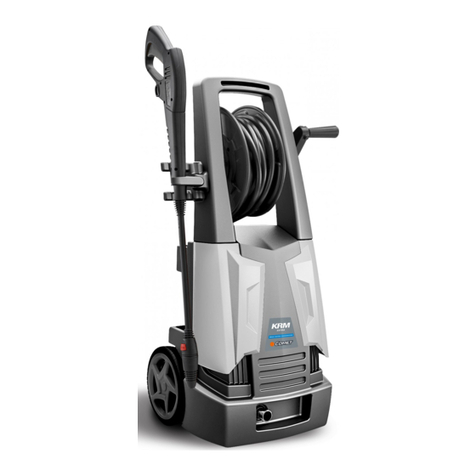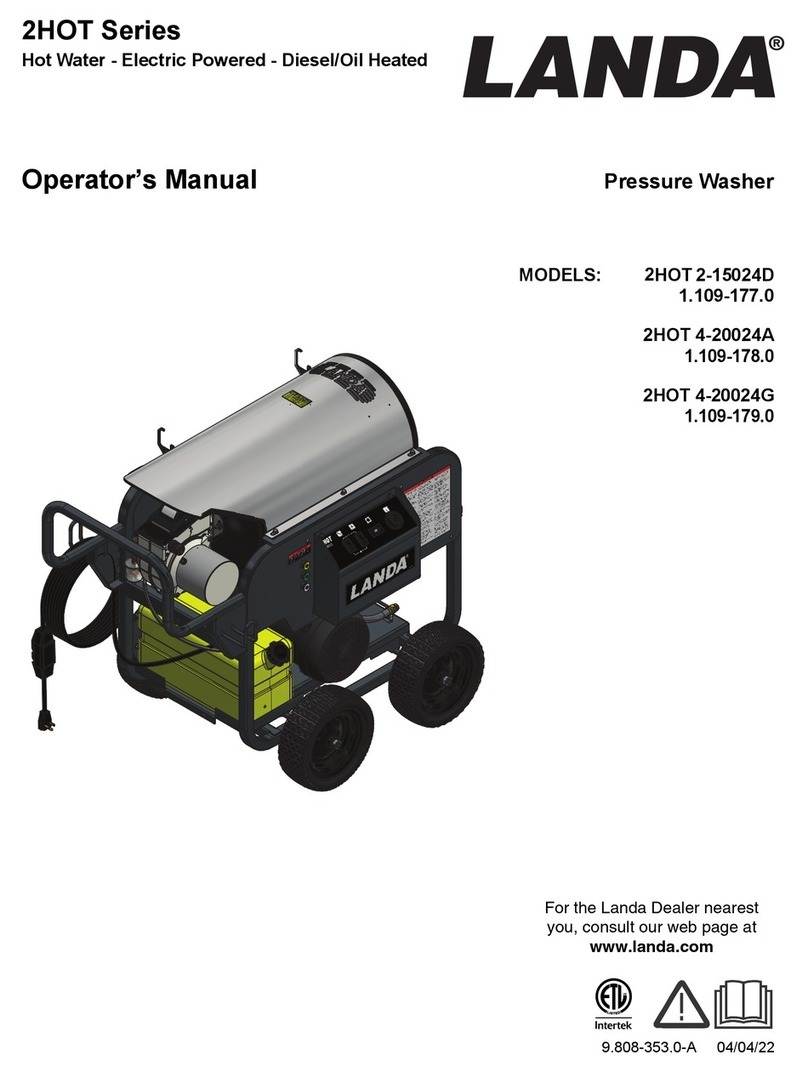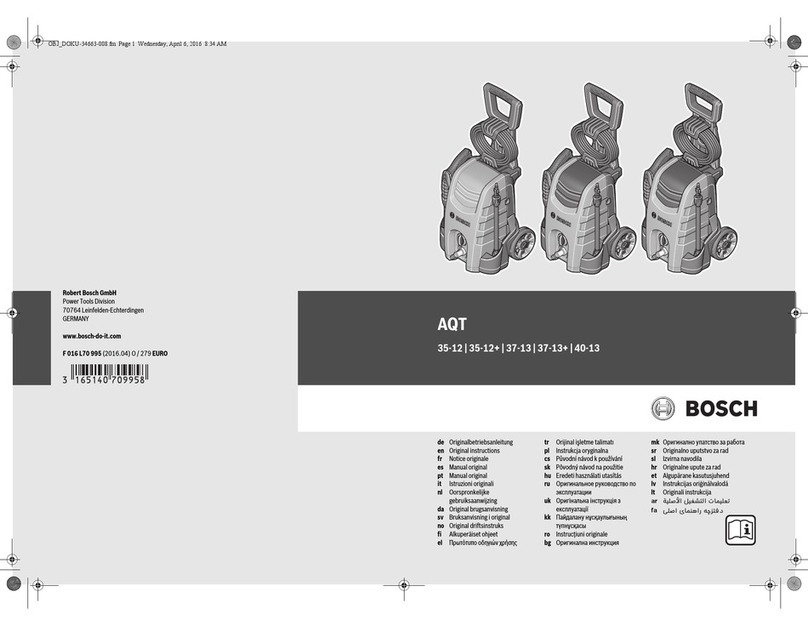Silverline 943676 User manual

Version date: 21.04.17 silverlinetools.com
Register online: silverlinetools.com
3
GUARANTEE
YEAR
ANS DE GARANTIE
JAHRE GARANTIE
AÑOS DE GARANTÍA
ANNI DI GARANZIA
JAAR GARANTIE
LATA GWARANCJI
XXXXXX
943676
FR Nettoyeur haute pression,2 100 W
DE Hochdruckreiniger,2100 W
ES Hidrolimpiadora,2100 W
IT Idropulitrice 2100 W
NL 2100 W hogedrukreiniger
PL Myjkawysokociśnieniowa2100W
2100W Pressure Washer 165bar Max
943676_Manual.indd 1 31/05/2017 10:36

2
1
2
10
1113
12
4
3
5
6
7
8
9
943676_Manual.indd 2 31/05/2017 10:36

silverlinetools.com
3
11
24 25
26
4
13
212019 22 23 14 15 16
17
18
943676_Manual.indd 3 31/05/2017 10:36

4
A
B
E
C
F
D
G
943676_Manual.indd 4 31/05/2017 10:37

silverlinetools.com
5
H
J
K
I
L
943676_Manual.indd 5 31/05/2017 10:37

6
Fig. I Fig. II
Fig. III Fig. IV Fig. V
Fig. VI
M
+
943676_Manual.indd 6 31/05/2017 10:37

silverlinetools.com
7
English ................08
Français ...............14
Deutsch................20
Español................26
Italiano................32
Nederlands ..........38
Polski ..................44
943676_Manual.indd 7 31/05/2017 10:37

GB
8
Technical Abbreviations Key
Voltage.....................................................230-240V~50Hz
Power...............................................................2100W
Working pressure (Bar) ...................................................110
Max pressure (Bar) . . . . . . . . . . . . . . . . . . . . . . . . . . . . . . . . . . . . . . . . . . . . . . . . . . . . . . .165
Workingowrate...................................................6.0L/min
Maximumowrate .................................................7.2L/min
High pressure hose length ................................................5m
Detergent tank capacity....................................................1L
Detergent ratio ......................................................Variable
Inlet water temperature range ..........................................5-50°C
Inlet water pressure .....................................................4bar
Protection class...........................................................
Ingress protection.......................................................IPX5
Power cord length .......................................................5m
Dimensions (L x W x H) .................................... 330 x 360 x 890mm
Weight................................................................20kg
Aspartofourongoingproductdevelopment,specicationsofSilverlineproducts
may alter without notice.
Sound & vibration information
According to Machinery Directive 2006/42/EC:
SoundpressureLPA . . . . . . . . . . . . . . . . . . . . . . . . . . . . . . . . . . . . . . . . . . . . . . . . . 76.7dB(A)
SoundpowerLWA..................................................89.71dB(A)
Uncertainty K..........................................................2.5dB
Weighted vibration ah...............................................<2.5m/s2
According to Outdoor Noise Directive 2000/14/EC:
Guaranteed sound power LWA ..........................................93dB(A)
The sound intensity level for the operator may exceed 85dB(A) and sound
protection measure are necessary.
Specication
Description of Symbols
The rating plate on your tool may show symbols.These represent important information about the
product or instructions on its use.
Wear hearing protection.
Wear eye protection.
Wear breathing protection.
Wear head protection.
Wear hand protection.
Read instruction manual.
Caution!
Risk of electrocution!
Class I construction (protective earth)
According to the applicable regulations,the appliance must never be used on the
drinking water supply without a system separator
Conforms to relevant legislation and safety standards
Environmental Protection
Waste electrical products should not be disposed of with household waste. Please
recycle where facilities exist.Check with your local authority or retailer for recycling
advice
VVolts
~, AC Alternating current
A, mA Ampere, milli-Amp
n0 No load speed
˚Degrees
Ø Diameter
Hz Hertz
W, kW Watt, kilowatt
/min or min-1 Operations per minute
Introduction
ThankyouforpurchasingthisSilverlinetool.Thismanualcontainsinformationnecessary
for safe and effective operation of this product.This product has unique features and,even if
you are familiar with similar products,it is necessary to read this manual carefully to ensure
you fully understand the instructions. Ensure all users of the tool read and fully understand
this manual.
Original Instructions
943676_Manual.indd 8 31/05/2017 10:37

2100W Pressure Washer943676
9
silverlinetools.com
WARNING:Always wear ear protection where the sound level exceeds 85dB(A) and limit the time
of exposure if necessary. If sound levels are uncomfortable,even with ear protection,stop using the
toolimmediatelyandchecktheearprotectioniscorrectlyttedandprovidesthecorrectlevelof
sound attenuation for the level of sound produced by your tool.
WARNING: User exposure to tool vibration can result in loss of sense of touch, numbness, tingling
and reduced ability to grip.Long-term exposure can lead to a chronic condition.If necessary,limit
the length of time exposed to vibration and use anti-vibration gloves. Do not operate the tool with
hands below a normal comfortable temperature,as vibration will have a greater effect.Use the
guresprovidedinthespecicationrelatingtovibrationtocalculatethedurationandfrequency
of operating the tool.
Soundandvibrationlevelsinthespecicationaredeterminedaccordingtointernationalstandards.
Theguresrepresentnormaluseforthetoolinnormalworkingconditions.Apoorlymaintained,
incorrectly assembled,or misused tool, may produce increased levels of noise and vibration.
www.osha.europa.eu provides information on sound and vibration levels in the workplace that
may be useful to domestic users who use tools for long periods of time.
Carefully read and understand this manual and any label attached to the tool before use.Keep these
instructions with the product for future reference.Ensure all persons who use this product are fully
acquainted with this manual.
Even when used as prescribed it is not possible to eliminate all residual risk factors.Use with
caution. If you are at all unsure of the correct and safe manner in which to use this tool, do not
attempt to use it.
General Safety
WARNING: Read all safety warnings, instructions, illustrations and specications
provided with this appliance. Failure to follow all instructions listed below may result in electric
shock, re and/or serious injury.
Save all warnings and instructions for future reference.
The term “appliance” in the warnings refers to your mains-operated (corded) appliance or battery-
operated (cordless) appliance.
1) Work area safety
a) Keep work area clean and well lit.Cluttered or dark areas invite accidents.
b) Do not operate appliances in explosive atmospheres, such as in the presence of
ammable liquids, gases or dust. Appliances create sparks which may ignite the dust or fumes.
c) Keep children and bystanders away while operating an appliance. Distractions can cause
you to lose control.
2) Electrical safety
a) Appliance plugs must match the outlet. Never modify the plug in any way. Do not use any
adapter plugs with earthed (grounded) appliances. Unmodied plugs and matching outlets
will reduce risk of electric shock.
b) Avoid body contact with earthed or grounded surfaces, such as pipes, radiators, ranges
and refrigerators. There is an increased risk of electric shock if your body is earthed or grounded.
c) Do not abuse the cord. Never use the cord for carrying, pulling or unplugging the
appliance. Keep cord away from heat, oil,sharp edges or moving parts. Damaged or
entangled cords increase the risk of electric shock.
d) When operating an appliance outdoors, use an extension cord suitable for outdoor use.
Use of a cord suitable for outdoor use reduces the risk of electric shock.
e) If operating an appliance in a damp location is unavoidable, use a residual current device
(RCD) protected supply. Use of an RCD reduces the risk of electric shock.
3) Personal safety
a) Stay alert, watch what you are doing and use common sense when operating an
appliance. Do not use an appliance while you are tired or under the inuence of drugs,
alcohol or medication. A moment of inattention while operating appliances may result in
serious personal injury.
b) Use personal protective equipment. Always wear eye protection. Protective equipment
such as a dust mask, non-skid safety shoes,hard hat or hearing protection used for appropriate
conditions will reduce personal injuries.
c) Prevent unintentional starting. Ensure the switch is in the OFF-position before connecting
to source and/or battery pack, picking up or carrying the appliance. Carrying appliances
with your nger on the switch or energising appliances that have the switch ON invites accidents.
d) Remove any adjusting key or wrench before turning the appliance ON. A wrench or a key
left attached to a rotating part of the appliance may result in personal injury.
e) Do not overreach. Keep proper footing and balance at all times. This enables better control
of the appliance in unexpected situations.
f) Do not let familiarity gained from frequent use of appliances allow you to become
complacent and ignore appliance safety principles. A careless action can cause severe injury
within a fraction of a second.
4) Appliance use and care
a) Do not force the appliance. Use the correct appliance for your application.The correct
appliance will do the job better and safer at the rate for which it was designed.
b) Do not use the appliance if the switch does not turn it ON and OFF. Any appliance that
cannot be controlled with the switch is dangerous and must be repaired.
c) Disconnect the plug from the source and/or remove the battery pack,if detachable,
from the appliance before making any adjustments, changing accessories, or storing
appliances. Such preventive safety measures reduce the risk of starting the appliance
accidentally.
d) Store idle appliances out of the reach of children and do not allow persons unfamiliar
with the appliance or these instructions to operate the appliance.Appliances are dangerous
in the hands of untrained users.
e) Maintain appliances and accessories. Check for misalignment or binding of moving parts,
breakage of parts and any other condition that may affect the appliance’s operation.
If damaged, have the appliance repaired before use. Many accidents are caused by poorly
maintained appliances.
f) Use the appliance, accessories and appliance bits,etc. in accordance with these
instructions, taking into account the working conditions and the work to be performed.
Use of the appliance for operations different from those intended could result in a hazardous
situation.
g) Keep handles and grasping surfaces dry, clean and free from oil and grease.Slippery
handles and grasping surfaces do not allow for safe handling and control of the appliance in
unexpected situations.
5) Service
a) Have your appliance serviced by a qualied repair person using only identical
replacement parts. This will ensure that the safety of the appliance is maintained.
Pressure Washer Safety
• Do not operate this appliance in the rain.Keep all electrical connections dry. Do not allow the
machine to become wet. Never allow water to enter ventilation holes
• Alwaysconnectabackowpreventer(alsocalledanon-returnvalve)betweenpressurewasher
andpotablewatermainstopreventabackowcontaminatingyourwatersupply.Alternatively,
connect the pressure washer to a water butt or other stored water supply
• Do not attempt to use this machine in temperatures below 0°C
• Alwaysconnecta‘continuousow’cleanwatersupplytothepressurewasher.Runningthe
pressure washer dry,or with dirty water,will cause permanent damage to the pump
• Never connect the pressure washer to a hot water supply; this will cause the pump to
malfunction and could result in permanent damage
• Ensure that the water supply to the pressure washer is at a constant pressure. If the water supply
is‘shared’byanotherappliance(e.g.washingmachine),ensurethattheotherapplianceis
switched OFF
• The pressure washer should always be used in an upright position
• Be aware that the lance will produce a recoil force when the pressure washer is operated. Hold
the lance securely
• Never direct the water jet at people or animals.The water jet is extremely powerful, and can cause
serious injury.Do not direct the water jet towards the pump body,or other electrical equipment
• Handle the lance with care, do not allow the nozzle to strike the ground.Do not allow the hoses
to be twisted, crushed,or strained
• Do not attempt to pressure wash any material suspected to contain asbestos
• When using detergents with pressure washers or cleaning oil and grease from surfaces,
take responsibility for any contaminated waste water you may produce.Always consider the
environment and the risk of polluting streams and other watercourses, plus the possibility of
contaminants accumulating in the ground and soil.Try to use detergents sparingly—they are not
always necessary. Contact your local environmental agency for how to deal with such waste water
legally and responsibly
943676_Manual.indd 9 31/05/2017 10:37

GB
10
1. High Pressure Hose Reel
2. Hose Reel Handle
3. Hose Connector
4. Power Cord Hook
5. ON/OFF Switch
6. Water Inlet
7. Nozzle Rest
8. Lance Bracket
9. Front Handle
10. Telescopic Rear Handle
11. Detergent Bottle
12. Wheels
13. Power Cord
14. Lance Handle Bayonet Socket
15. Lance High Pressure Hose Connector
16. Lance Handle Grip
17. Trigger
18. Trigger Lock
19. Nozzle
20. Pressure Adjustment
21. Nozzle Bayonet Connector
22. Lance Extension Bayonet Socket
23. Lance Extension Bayonet Connector
24. Cleaning Pin
25. Inlet Hose Connector
26. Rear Handle Release Button
Product Familiarisation
Intended Use
Pressure washer for general, light to medium duty cleaning tasks on vehicles, buildings and other
suitable surfaces, using a jet of cold, pressurised water,with or without detergent.
Unpacking Your Tool
• Carefully unpack and inspect your product.Fully familiarise yourself with all its features and
functions
• Ensure that all parts of the product are present and in good condition. If any parts are missing or
damaged, have such parts replaced before attempting to use this product
Before Use
• Always check all parts and attachments are secure,and that hoses are not kinked or obstructed
• Always wear appropriate personal protective equipment for the job at hand.Use of this appliance
requires safety goggles and waterproof clothing
• Always use an RCD when connecting a pressure washer to the mains with a tripping current of no
more than 30mA, and a delay in operating of no more than 30ms
• Make sure mains connection points are out of reach of the pressure washer water spray and any
water that may collect on surrounding surfaces
• Only use a mains extension cable suitable for outdoor use and capable of carrying the required
current for this product.The cable must be protected against water ingress and maintain water-
tight connections where it connects to the pressure washer
• This product must be earthed and any extension cables used must have an earth connection
• Alwaysusethepressurewasherverticallyandmakesureitisusedonaat,levelsurface
Assembly
• Do not connect the pressure washer to the water or electrical supply until fully assembled and
ready for use
• Remove all packaging materials from the product
Hooks & holders
• SlidetheLanceBracket(8)downontothesideclip(Fig.I)
• SlidetheNozzleRest(7)backontotheclip(Fig.II)andxwiththesuppliedscrew
• SlidethePowerCordHook(4)downontothesideclip(Fig.III)
Lance
• Assemble the Lance by connecting the Nozzle (19) shaft to the lance extension shaft,and these to
the lance handle (Image A)
• Todothis,inserttheNozzleBayonetConnector(21)intotheLanceExtensionBayonetSocket
(22), then push and rotate to lock into place (Image B)
• InserttheLanceExtensionBayonetConnector(23)intotheLanceHandleBayonetSocket(14),
then push and rotate to lock into place (Image C)
Note: When not in use, the assembled lance can be held in the Lance Bracket (8) with the Nozzle
(19) in the Nozzle Rest (7) (Image D).
High pressure hose
1. Carefully pull out a length of hose from the High Pressure Hose Reel (1) (Image E)
2. Attach the end of the hose to the Lance High Pressure Hose Connector (15) (Image F) and screw
the nut on tight
WARNING: If the high pressure hose is damaged it could burst and cause injury.A damaged hose
must be replaced, not repaired. Inspect regularly and prevent the hose from coming into contact
with sharp objects or rough surfaces.After use, always wind the hose back in using the Hose Reel
Handle (2) (Image G then H).
Connecting to water supply
WARNING: When connecting a pressure washer to a normal domestic water supply, it is important a
non-returnvalveisttedtothehose(alsocalledbackowpreventer)toensurethepressurewasher
cannotcontaminateyourwatersupplyifthereisabackow.
1. RemovetheplasticcapfromtheWaterInlet(6)(Fig.IV)andcheckthatthelterinsideisclearof
debris or other material; clean if required
2. Fit the Inlet Hose Connector (25) (Fig.V) and tighten by hand
3. Connect a hose from your water supply to the Inlet Hose Connector
Notes:
• Thespecicationlistssuitablewaterinletpressures.Atypical,normalUKhouseholdwatersupply
can range from 1–8bar pressure but 2–5bar is more typical.Do not exceed the maximum water
pressurestatedinthespecication
• If you do not know or are unable to measure the water pressure,keep the pressure low to prevent
damage to the pressure washer.Aim to set the pressure at mid-point between the lowest and
highest pressure accepted by the pressure washer.If preferred,a third party water pressure
gauge is available that connects directly to the tap.This will allow the water pressure to be set
more accurately
• Do not connect to a hot water supply.This will prevent the pump from cooling and may damage
the seals over time
• It is important that a good water connection is maintained while operating a pressure washer as
the pump will be damaged if run without water. Make sure the connections are secure before
switching on the pressure washer
Connecting to other water sources
Note: The pump featured in this pressure washer features a self-priming feature that allows use of
other water sources typically a water butt or other container of captured rain water or similar.
• Ensurethewatersupplyiscleanandlteredbeforeenteringthepressurewasher.Ensurethereis
no sediment
• For water butts,where the output is at the bottom, gravity will provide some pressure to assist the
pressure washer
• The hose to the water supply should not exceed 3m in length and the diameter should not be
less than 19mm or ¾”
Filling the detergent bottle
• RemovethecapontheDetergentBottle(11)andllwithapressurewasher-compatible
detergent if required (Image I)
• The pressure washer is designed to dispense detergent on the low pressure setting,and dispense
clear liquid on the high pressure setting
• The detergent ratio is variable depending on the pressure adjuster setting
943676_Manual.indd 10 31/05/2017 10:37

2100W Pressure Washer943676
11
silverlinetools.com
Adjusting the telescopic rear handle
• Press the Rear Handle Release Button (26) and raise or lower the Telescopic Rear Handle (10)
(Image K)
Operation
Switching ON
• Always open the water supply tap before switching the pressure washer ON,to protect the pump
from damage
• SettheTriggerLock(18)topreventtheTrigger(17)frombeingpressed(ImageJ)
• ConnectthepressurewashertothemainspowersupplyandmovetheON/OFFSwitch(5)toON
(Fig.VI). The pump will operate immediately to build up pressure and each time theTrigger is
pressedtorestorewaterpressure.WhenrstswitchedON,thepumpmayoperatecontinuously
until the trigger is pressed.Do not allow this to exceed 3 minutes.Press and release the Trigger
to deactivate this mode and ideally start using within 2 minutes of switching ON
• It is important that all air is bled from the hoses and lance before using the pressure washer.
Disable the Trigger Lock and squeeze and hold theTrigger until water is sprayed in a steady
stream.Thismaytakeupto2minutesorpossiblylongeronrstuse
Switching OFF
• Whenyouhavenishedusingtheappliance,alwaysperformthefollowingsteps:
1. SwitchOFFtheapplianceanddisconnectfromthemainspowersupply
2. Turn OFF the water supply
3. SqueezetheTrigger(17)andallowallresidualwaterpressuretobleed
4. Disconnect the water supply
5. Drain all water from the appliance and hoses, and store in a dry place
WARNING: Do not switch OFF the water supply before turning OFF the pump as the pump must
not be run without water.
WARNING: Neverdisconnectthehighpressurehoseateitherendwithoutdepressurisingrst.
Using your pressure washer
• To spray water,ensure you are holding the lance securely with both hands and squeeze the
Trigger (17).Beware of slight recoil
• TodisabletheTrigger,usetheTriggerLock(18)whennecessary(ImageJ)
• The Nozzle (19) is adjustable for a wide fan pattern and a strong narrow jet by rotating (Image M)
• Experiment with narrower patterns and different spray distances until the correct strength is
achieved. Release the Trigger when changing the setting
• Use the Pressure Adjustment (20) (Image M) to adjust pressure output. Release the Trigger when
changing the setting
• The pressure washer will protect the motor from over-heating if used continuously for too long,
and will prevent the Trigger from operating. It will reset after cooling for a few minutes.It is
recommended to have a work pattern that prevents the over-heating protection feature activating
by not holding down the trigger continuously
• If you are unsure of the durability of the surface that is being cleaned,avoid using the narrow jet
setting.Reduce the pressure and start at a longer distance from the surface
• It is recommended to hold the lance at an angle of 45° to the surface being cleaned.This will
give maximum control, and most effective cleaning
• Alwaystest-cleananinconspicuousarearsttocheckthatthecleaningprocessordetergentwill
not damage the surface being cleaned, especially mortar between bricks or patio slabs, which
can be easily removed with a pressure washer if not careful
Using detergent
• Many products are available that are suitable for pressure washers,including patio cleaners,
glasscleaners,carshampoos,trafclmremovers,woodandplasticcleaningsolutions,and
general pressure washer detergents.
• Fill the Detergent Bottle (11) with the required detergent solution
• Dispense the detergent on a low pressure setting by adjusting the Pressure Adjustment (20)
(ImageM),whichismarkedwith‘-‘and‘+’
• Increase the pressure with the PressureAdjustment and spray away the detergent with a clear
spray
Notes:
• Atypicalpatternofuseforusingdetergentfoamwouldberstcleaningwithwatertoremove
lightsurfacedeposits,thenapplydetergentfoam,andthennallyrinseoffwithcleanwater
• Detergent foam requires a few minutes to work when applied to surfaces.Normally for maximum
cleaning, leave for 2–5 minutes between applying foam and removing with clean water, which
is an ideal time to brush/scrub the surface where most dirt has collected.Do not allow foam to
dry on the surface, for instance on a hot day there may be limited time between dispensing foam
and rinsing off depending on the surface
• Do not use detergents not designed for pressure washers.They may contain chemicals
unsuitable for use with pressure washers that could damage seals
• Read the instructions provided with the detergent thoroughly, especially if concentrated. Diluting
tothedetergentmanufacturer’srecommendationswillensureeffectivecleaningwithoutusing
excessive detergent.As this pressure washer has a variable detergent ratio,set to a middle
pressure setting and adjust the pressure downwards until a satisfactory detergent mixture is
achieved
Accessories
• ArangeofaccessoriesisavailablefromyourSilverlinestockisttoenhancethefunctionalityof
yourpressurewasher,includingbrushesandreplacementorhigherspecicationparts
Maintenance
Cleaning
• Keep your appliance clean at all times
• Always allow all water to drain from the pump before storing
• The lance Nozzle (19) may become dirty or blocked over time,which will affect operation.Clean
the lance nozzle using the Cleaning Pin (24) (Image L) supplied.A garden hose can also be
usedtocleanthenozzlebyback-ushingwaterthroughthenozzle.Combininguseofthepin
andback-ushingshouldenablethenozzletobefullycleaned.Thefrequencyofdoingthiswill
depend on the water quality in your area with hard water areas requiring more frequent cleaning
• RegularlychecktheInletHoseConnector(25)ltertomakesureitisclear.Thisltermustbe
checked regularly to ensure it is clear from debris and other materials.Remove the Inlet Hose
Connectortoaccessthelter
Storage
• Always store this machine in a dry place that will not fall below 0°C
Disposal
Always adhere to national regulations when disposing of power tools that are no longer functional
and are not viable for repair.
• Do not dispose of power tools, or other waste electrical and electronic equipment (WEEE),with
household waste
• Contact your local waste disposal authority for information on the correct way to dispose of power
tools
943676_Manual.indd 11 31/05/2017 10:37

GB
12
Problem Possible Cause Solution
No detergent suction Lance not in low pressure mode Change setting with trigger released
Smoke Overload or damaged motor DONOTUSE.ContactdealerorauthorisedSilverlineservicecentreimmediately
Pressurewasherdoesn’tstart
Pressurised Squeezetriggerongunbeforestarting
Mains plug not fully inserted or mains socket is switched
OFF Check and correct issues
RCD has operated or not been reset Reset RCD
Plug fuse has blown (UK only) Replace fuse and contact dealer if it blows again immediately
Thermal safety switch has operated SwitchOFFandallowpressurewashermotortocoolbeforestarting
Poor water spray pressure
Waterinletlterisclogged Cleanlter
Water hose connection is leaking or allowing air to enter Check water hose connection
Pressure washer valves or seals are worn or damaged ContactdealerorauthorisedSilverlineservicecentreimmediately
Fluctuating water pressure
Pump is sucking in air Check water hose connections
Clogged nozzle SeeMaintenanceforcleaningprocedure
Motor stops suddenly Thermal safety switch has operated SwitchOFFandallowtocoolbeforerestarting
Water leaking from pump Sealswornout ContactdealerorauthorisedSilverlineservicecentreimmediately
Troubleshooting
943676_Manual.indd 12 31/05/2017 10:37

2100W Pressure Washer943676
13
silverlinetools.com
Terms & Conditions
Silverline Tools Guarantee
This Silverline product comes with a 3 year
guarantee
Register this product at www.silverlinetools.com within 30 days of purchase in order to qualify
for the 3 year guarantee.Guarantee period begins according to the date of purchase on your
sales receipt.
Registering your purchase
Registration is made at silverlinetools.com by selecting the Guarantee Registration button. You
will need to enter:-
• Your personal details
• Details of the product and purchase information
OncethisinformationisenteredyourguaranteecerticatewillbecreatedinPDFformatforyou
to print out and keep with your purchase.
Guarantee period becomes effective from the date of retail purchase as detailed on your sales
receipt.
PLEASE KEEP YOUR SALES RECEIPT
If this product develops a fault within 30 days of purchase,return it to the stockist where it
was purchased, with your receipt, stating details of the fault.You will receive a replacement
or refund.
If this product develops a fault after the 30 day period, return it to:
Silverline Tools Service Centre
PO Box 2988
Yeovil
BA21 1WU, UK
The guarantee claim must be submitted during the guarantee period.
You must provide the original sales receipt indicating the purchase date,your name, address
and place of purchase before any work can be
carried out.
You must provide precise details of the fault requiring correction.
ClaimsmadewithintheguaranteeperiodwillbeveriedbySilverlineToolstoestablishifthe
decienciesarerelatedtomaterialormanufacturingoftheproduct.
Carriage will not be refunded.Items for return must be in a suitably clean and safe state for
repair,and should be packaged carefully to prevent damage or injury during transportation. We
may reject unsuitable or
unsafe deliveries.
AllworkwillbecarriedoutbySilverlineToolsoritsauthorized
repair agents.
The repair or replacement of the product will not extend the period
of guarantee
Defects recognised by us as being covered by the guarantee shall be corrected by means of
repair of the tool, free of charge (excluding carriage charges) or by replacement with a tool in
perfect working order.
Retained tools, or parts,for which a replacement has been issued, will become the property of
SilverlineTools.
Therepairorreplacementofyourproductunderguaranteeprovidesbenetswhichare
additional to and do not affect your statutory rights as a consumer.
What is covered:
Therepairoftheproduct,ifitcanbeveriedtothesatisfactionofSilverlineToolsthatthe
deciencieswereduetofaultymaterialsorworkmanshipwithintheguaranteeperiod.
Ifanypartisnolongeravailableoroutofmanufacture,SilverlineToolswillreplaceitwitha
functional replacement part.
Use of this product in the EU.
What is not covered:
SilverlineToolsdoesnotguaranteerepairsrequiredasaresultof:
Normal wear and tear caused by use in accordance with the operating instructions eg blades,
brushes, belts, bulbs, batteries etc.
The replacement of any provided accessories drill bits, blades,sanding sheets, cutting discs and
other related items.
Accidental damage, faults caused by negligent use or care,misuse, neglect, careless operation
or handling of the product.
Use of the product for anything other than normal domestic purposes.
Changeormodicationoftheproductinanyway.
UseofpartsandaccessorieswhicharenotgenuineSilverlineToolscomponents.
Faultyinstallation(exceptinstalledbySilverlineTools).
RepairsoralterationscarriedoutbypartiesotherthanSilverlineToolsoritsauthorizedrepair
agents.
Claims other than the right to correction of faults on the tool named in these guarantee
conditions are not covered by the guarantee.
CE Declaration of Conformity
The undersigned: Mr Darrell Morris
as authorised by: SilverlineTools
Declares that
This declaration has been issued under the sole responsibility of the manufacturer.
The object of the declaration is in conformity with the relevant Union harmonisation Legislation.
Identication code: 943676
Description: 2100W Pressure Washer
Conforms to the following directives and standards:
• Machinery Directive 2006/42/EC
• EMC Directive 2014/30/EU
• RoHSDirective2011/65/EU
• Outdoor Noise Directive 2000/14/EC
• EN 60335-1:2012+A11:2014
• EN 60335-2-79:2012
• EN 62233:2008
• EN 55014-1:2006+A1:2009+A2:2011
• EN 55014-2:2015
• EN 61000-3-2:2014
• EN 61000-3-3:2013
Applied Conformity Evaluation Method
2000/14/EC: Annex III
Sound Power Level dB (A)
Measured: 89.71
Guaranteed: 92
Notied body: SGS
The technical documentation is kept by: SilverlineTools
Date: 21/04/2017
Signed:
Mr Darrell Morris
Managing Director
Name and address of the manufacturer:
Powerbox International Limited, Company No.06897059. Registered address:
Powerbox,BoundaryWay,LuftonTradingEstate,Yeovil,SomersetBA228HZ,UnitedKingdom.
943676_Manual.indd 13 31/05/2017 10:37

FR
14
Abréviations pour les termes
techniques
Introduction
Nousvousremercionsd’avoirchoisicetéquipementSilverline.Cesinstructionscontiennentles
informationsnécessairespourvousengarantirunfonctionnementefcaceetentoutesécurité.
Veuillez lire attentivement ce manuel pour vous assurer de tirer pleinement avantage des
caractéristiquesuniquesdevotrenouveléquipement.
Gardezcemanuelàportéedemainetassurez-vousquetouslesutilisateursl’aientluetbien
comprisavanttouteutilisation.Conservez-lepourtouteréférenceultérieure.
Traduction des instructions originales
Tension : . . . . . . . . . . . . . . . . . . . . . . . . . . . . . . . . . . . . . . . . . . . . . . . . . . . 230-240 V~50 Hz
Puissance : ......................................................... 2 100 W
Pression de service :...................................................110 bar
Pression maximale : ..................................................165 bar
Débitdeservice ......................................................6 L/min
Débitmaximum: ..................................................7,2 L/min
Longueur du tuyau haute pression : ........................................5 m
Capacitéduréservoirdudétergent:.........................................1 L
Ratiodétergent:......................................................Variable
Plagedetempératuredel’eauàl’entrée:.................................5 - 50°C
Pressiondel’eauàl’entrée: ..............................................4 bar
Classe de protection :......................................................
Indice de protection : ....................................................IPX5
Longueurducâbled’alimentation:.........................................5 m
Dimensions (L x l x H) : .................................... 330 x 360 x 890 mm
Poids : ................................................................20 kg
Dufaitdel’évolutionconstantedenosproduits,lescaractéristiquesdesproduitsXXX
peuventchangersansnoticationpréalable.
Informations relatives au niveau d’intensité sonore et vibratoire
Conformémentàladirectivesurlesmachines2006/42/CE
Pression acoustique (LPA): ........................................... 76,7 dB(A)
Puissance acoustique (LWA):.........................................89,71 dB(A)
Incertitude :.........................................................2,5 dB(A)
Vibrationpondéréeah: ...............................................2,5 m/s²
Conformémentàladirectivesurlesémissionssonoresdansl’environnementdes
matérielsdestinésàêtreutilisésàl’extérieurdesbâtiments2000/14/CE
Puissance acoustique garantie LWA :.....................................93 dB(A)
L’intensitésonorepeutdépasser85dB(A)etilestnécessairequel’utilisateurportedes
protections auditives.
Caractéristiques techniques
Description des symboles
Laplaquesignalétiquegurantsurvotreoutilpeutprésenterdessymboles.Cessymboles
constituent des informations importantes relatives au produit ou des instructions concernant son
utilisation.
Port de protection auditive
Portdelunettesdesécurité
Port de masque respiratoire
Port de casque
Port de gants
Lirelemanueld’instructions
Attention !
Risqued’électrocution!
Construction de classe I (Mise à la terre)
Enconformitéaveclesréglementationsenvigueurpertinentes,l’appareilne
doitjamaisêtreraccordéàunesourced’approvisionnementeneaupotablesans
séparateur!
Conformeauxréglementationsetauxnormesdesécuritépertinentes.
Protectiondel’environnement
Lesappareilsélectriquesusagésnedoiventpasêtrejetésaveclesordures
ménagères.Veuillezlesrecyclerdanslescentresprévusàceteffet.Pourdeplus
amplesinformations,veuillezcontactervotremunicipalitéoupointdevente.
VVolt
~, AC Courant alternatif
A, mA Ampère,Milliampère
n0 Vitesse à vide
˚Degrés
ØDiamètre
Hz Hertz
W, kW Watt, kilowatt
/min or min-1 (opérations)parminute
943676_Manual.indd 14 31/05/2017 10:37

Nettoyeur haute pression, 2 100 W943676
15
silverlinetools.com
AVERTISSEMENT : Porteztoujoursdesprotectionsauditiveslorsqueleniveaud’intensitéest
supérieurà85dB(A)etlimitezletempsd’expositionsinécessaire.Sil’intensitésonoredevient
inconfortable,mêmeaveclesprotections,arrêtezimmédiatementd’utiliserl’appareil,vériezque
lesprotectionssontbienenplacesetadaptésavecleniveausonoreproduitparl’appareil.
AVERTISSEMENT : L’expositiondel’utilisateurauxvibrationspeutengendrerunepertedutoucher,
desengourdissements,despicotementsetainsiréduirelacapacitédepréhension.Delongues
expositionspeuventégalementprovoquercessymptômesdefaçonchronique.Sinécessaire,
limitezletempsd’expositionauxvibrationsetportezdesgantsanti-vibrations.N’utilisezpascet
appareillorsquelatempératuredevosmainsestendessousdestempératuresnormales,carl’effet
vibratoireenestaccentué.Référez-vousauxchiffresindiquésdanslescaractéristiquestechniques
descaractéristiquesrelatifsauxvibrationspourcalculerletempsetlafréquenced’utilisationde
l’appareil.
Lesniveauxsonoresetvibratoiresindiquésdanslasection«Caractéristiquestechniques»
duprésentmanuelsontdéterminésenfonctiondenormesinternationales.Cesdonnées
correspondentàunusagenormaldel’appareil,etcedansdesconditionsdetravailnormales.
Unappareilmalentretenu,malassembléoumalutilisépeutaugmenterlesniveauxsonoreset
vibratoires. Le site www.osha.europa.eu offre de plus amples informations sur les niveaux sonores
etvibratoiressurlelieudetravail,celles-cipourrontêtreutilesàtoutparticulierutilisantdesoutils
électriquespendantdespériodesprolongées.
Veuillezlireattentivementetassimilerlesinformationscontenuesdansleprésentmanuelainsi
quetoutementionéventuellementapposéesuruneétiquetteprésentesurvotreappareilmême
avantd’entreprendred’utilisercetappareil.Veuillezconservercesinstructionsetconsignesde
sécuritépourréférenceultérieure.Assurez-vousquetouteslespersonnesquiutiliserontceproduit
aientprispleinementconnaissancedesprésentesinstructions.
Mêmes’ilestutiliséselonl’usageconformeetdanslerespectdesprésentesconsignesdesécurité,
ilestimpossibled’éliminertoutfacteurderisque.Àutiliserenprenantuneextrêmeprécaution.
Sivousavezunquelconquedoutesurlamanièred’utilisercetappareilentoutesécurité,
n’entreprenezpasdevousenservir.
Consignes de sécurité générales
relatives à l’utilisation d’appareils
électriques
AVERTISSEMENT: Veuillez lire toutes les consignes de sécurité et toutes les instructions
dispensées dans le présent manuel. Le non-respect des instructions et consignes de sécurité peut
entraîner un risque de décharge électrique, d’incendie et/ou se traduire par des blessures graves.
Veuillez conserver ces instructions et consignes de sécurité pour référence ultérieure.
L’expression «appareil électrique» employée dans les présentes consignes recouvre aussi bien les
appareils laires à brancher sur secteur que les appareils sans ls fonctionnant avec batterie.
1) Sécurité sur la zone de travail
a. Maintenir une zone de travail propre et bien éclairée. Des zones encombrées et mal éclairées
sont sources d’accidents.
b. Ne pas utiliser d’appareils électriques dans des environnements explosifs, tels qu’à
proximité de liquides, de gaz ou de poussières inammables. Les appareils électriques
produisent des étincelles susceptibles d’enammer la poussière ou les vapeurs présentes.
c. Éloigner les enfants et toute personne se trouvant à proximité pendant l’utilisation d’un
appareil électrique. Ceux-ci pourraient vous distraire et vous faire perdre la maîtrise de l’appareil.
2) Sécurité électrique
a. Les prises des appareils électriques doivent correspondre aux prises du secteur. Ne
modiez jamais la prise en aucune façon. N’utilisez jamais d’adaptateur avec les appareils
électriques mis à la terre. Des prises non modiées, adaptées aux boîtiers de prise de courant,
réduiront les risques de décharge électrique.
b. Éviter le contact corporel avec les surfaces mises à la terre telles que tuyaux, radiateurs,
cuisinières et réfrigérateurs. Le risque de décharge électrique est plus important si votre corps
est mis à la terre.
c. Ne pas maltraiter le cordon électrique. N’utilisez jamais le cordon électrique pour porter,
tirer ou débrancher l’appareil électrique. Conservez le cordon électrique à l’écart de
la chaleur, de l’essence, de bords tranchants ou de pièces en mouvement. Un cordon
électrique endommagé ou entortillé accroît le risque de décharge électrique.
d. Au cas où l’appareil électroportatif serait utilisé à l’extérieur, servez-vous d’une rallonge
appropriée à une utilisation en extérieur. Cela réduit le risque de décharge électrique.
e. Si une utilisation de l’appareil dans un environnement humide ne peut être évitée, utilisez
une alimentation protégée par un disjoncteur différentiel.L’utilisation d’un disjoncteur
différentiel réduit le risque de décharge électrique.
3) Sécurité des personnes
a. Rester vigilant et faire preuve de bon sens lors de la manipulation de l’appareil. Ne pas
utiliser d’appareil électrique en état de fatigue ou sous l’inuence de drogues, d’alcool ou
de médicaments. Un moment d’inattention pendant l’utilisation d’un appareil électrique peut se
traduire par des blessures graves.
b. Porter des équipements de protection. Porter toujours des lunettes de protection. Le port
d’équipements de protection tels que des masques à poussières, des chaussures de sécurité
antidérapantes, un casque de sécurité ou des protections antibruit, selon le travail à effectuer,
réduira le risque de blessures aux personnes.
c. Éviter tout démarrage accidentel. S’assurer que l’interrupteur marche-arrêt soit en position
d’arrêt (Off) avant de brancher l’appareil sur l’alimentation secteur. Porter un appareil
électrique tout en maintenant le doigt posé sur l’interrupteur ou brancher un appareil électrique
dont l’interrupteur est sur la position de marche (On) est source d’accidents.
d. Enlever toute clé ou tout instrument de réglage avant de mettre l’appareil électrique en
marche. Une clé ou un instrument de réglage resté xé à un élément en rotation de l’appareil
électrique peut entraîner des blessures physiques.
e. Ne pas essayer d’atteindre une zone hors de portée. Se tenir toujours en position stable et
conserver l’équilibre. Cela permet de mieux contrôler l’appareil électrique dans des situations
inattendues.
f. Ne relâchez pas votre vigilance sous prétexte qu’un usage fréquent vous donne
l’impression de vous sentir sufsamment en conance et familier avec l’appareil et son
utilisation. Les consignes de sécurité ne doivent en aucun cas être ignorées. Une action
inconsidérée qui ne durerait ne serait-ce qu’une fraction de seconde pourrait entraîner un
accident impliquant de graves blessures.
4) Utilisation et entretien d’appareils électriques
a. Ne pas surcharger l’appareil électrique. Utiliser l’appareil électrique approprié au travail
à effectuer. Un appareil électrique adapté et employé au rythme pour lequel il a été conçu
permettra de réaliser un travail de meilleure qualité et dans de meilleures conditions de sécurité.
b. Ne pas utiliser un appareil électrique dont l’interrupteur marche-arrêt est hors service.
Tout appareil électrique dont la commande ne s’effectue plus par l’interrupteur marche-arrêt est
dangereux et doit être réparé.
c. Débrancher l’appareil électrique avant d’effectuer tout réglage, changement d’accessoire
ou avant de le ranger.De telles mesures préventives réduiront les risques de démarrage
accidentel.
d. Ranger les appareils électriques inutilisés hors de portée des enfants et ne pas permettre
l’utilisation de ces appareils aux personnes novices ou n’ayant pas connaissance de
ces instructions. Les appareils électriques sont dangereux dans les mains d’utilisateurs
inexpérimentés.
e. Veiller à l’entretien des appareils électriques. Vérier que les éléments rotatifs soient
bien alignés et non grippés. S’assurer de l’absence de pièces cassées ou endommagées
susceptibles de nuire au bon fonctionnement de l'appareil. Si l’appareil électrique est
endommagé, le faire réparer avant toute utilisation. De nombreux accidents sont causés par
l’utilisation d’appareils électriques mal entretenus.
f. Utiliser l’appareil électrique, les accessoires et les appareils à monter, etc., conformément
à ces instructions et selon l’utilisation prévue pour le type d’appareil donné, en tenant
compte des conditions de travail et de la tâche à réaliser. Toute utilisation de cet appareil
électrique autre que celle pour laquelle il a été conçu peut entraîner des situations à risque et
entraînerait une annulation de sa garantie.
g. Veillez à ce que les poignées et toute surface de préhension de l’appareil soient toujours
propres, sèches et exemptes d’huile et de graisse. Une poignée ou une surface de préhension
rendue glissante ne consentirait pas à l’utilisateur de conserver une parfaite maîtrise de son
appareil en toutes circonstances.
5) Entretien
a. Ne faire réparer l’appareil électrique que par un réparateur qualié utilisant uniquement
des pièces de rechange identiques. Cela permettra d’assurer la sécurité continue de cet
appareil électrique.
Consignes de sécurité relatives aux
nettoyeurs haute pression
• N’utilisezpascetappareilsouslapluie.Assurez-vousquelesraccordementsélectriquessoient
secs.Veillezàcequel’appareilnesoitjamaishumide.Nelaissezjamaisl’eaupénétrerparles
oricesdeventilation.
• Branchez toujours une valve anti-retour entre le tuyau du nettoyeur haute pression et le robinet
pouréviterunecontaminationdel’eau.
• Netentezpasd’utilisercetappareilàunetempératureinférieureà0°C.
• L’appareildoittoujoursêtreraccordéàunesourced’approvisionnementeneaupropreet
courante(robinet).Touteopérationentrepriseàsecouavecdel’eausalepourraitoccasionnerdes
dommagesirrémédiablessurlapompe.
• Lenettoyeurhautepressionnedoitjamaisêtreraccordéàunesourced’approvisionnementen
eau chaude. Cela pourrait provoquer un dysfonctionnement ou un endommagement permanent
del’appareil.
• Assurez-vousquel’approvisionnementeneaudunettoyeursoitàpressionconstante.Si
l’approvisionnementeneaudessertégalementunautreéquipement(parex.machineàlaver),
assurez-vousquel’autreappareilsoitéteint.
• Lenettoyeurdoittoujoursêtreutiliséenpositionverticale.
• Gardezàl’espritl’effetdebondenarrièrequelalancepeutproduirelorsquelenettoyeurest
misenmarche.Preneztoujourslalancebienenmainavantd’activerl’appareil.
• Nedirigezjamaislejetversdespersonnesoudesanimaux.Lejetd’eauesttrèspuissantetpeut
causerdesblessuressévères.N’orientezjamaislejetversl’appareillui-mêmeniverstoutautre
équipementélectrique.
• Manipulezlalanceavecprécaution.L’emboutnedoitenaucuncaspercuterlesol.Veillezàce
queletuyaunesoitnientortillé,niécrasé,nitroptendu.
• N’essayezjamaisd’utiliserunnettoyeurhautepressionpournettoyerunesurfacequipourrait
contenirdel’amiante.
943676_Manual.indd 15 31/05/2017 10:37

FR
16
• Sivousavezrecoursàdesdétergentsousivousprocédezàunnettoyagevisantàéliminerhuiles
etgraissesd’unesurface,vousêtesalorsresponsabledutraitementdetouteeaucontaminéequi
pourraitenrésulter.Vousdeveztoujoursprendreenconsidérationlerespectdel’environnement
etlerisquedepollutiondescoursd’eauetdetouteautresourcesd’eau,ainsiquel’éventualité
decontaminerlessolsetleseauxsouterraines.Essayezdelimiterlerecoursàdesdétergents–
leurutilisationn’estpastoujoursnécessaire.Veuillezcontactervotreagencelocaleenchargede
l’environnementpoursavoircommentadopterlesbonsgestesparrapportautraitementdece
typededéchetsetagirdefaçonresponsableetdanslerespectdesloisenvigueur.
1. Dévidoir du tuyau haute pression
2. Manivelle du dévidoir
3. Raccord du tuyau
4. Crochet de rangement du cordon électrique
5. Interrupteur marche-arrêt
6. Prise d’arrivée d’eau
7. Support porte-buse
8. Porte-lance
9. Poignée avant
10. Poignée arrière télescopique
11. Réservoir pour le détergent
12. Roues
13. Cordon électrique
14. Prise baïonnette de la poignée pistolet de la lance
15. Raccord du tuyau haute pression sur la lance
16. Poignée pistolet de la lance
17. Gâchette
18. Verrouillage de la gâchette
19. Buse
20. Réglage de la pression
21. Raccord baïonnette de la buse
22. Prise baïonnette de la rallonge de la lance
23. Raccord baïonnette de la rallonge de la lance
24. Tige de nettoyage
25. Raccord d’arrivée d’eau
26. Bouton de déclenchement de la poignée arrière
Descriptif du produit
Usage conforme
Nettoyeurhautepressionindiquépourtâchesdenettoyaged’intensitélégèreàmoyennesur
véhicules,bâtimentsettouteautresurfacecompatible,àl’aided’unjetd’eaufroidepressurisée,
avecousansl’ajoutdedétergent.
Déballage
•Déballezleproduitavecsoin.Veillezàretirertoutlematériaud’emballageetfamiliarisez-vous
avectouteslescaractéristiquesduproduit.
•Sidespiècessontendommagéesoumanquantes,faites-lesréparerouremplaceravantd’utiliser
l’appareil.
Avant utilisation
• Toujoursvérierquechaquepiècedunettoyeurestassembléeetxéecorrectementetqueles
tuyauxnesoientpasentortillésniobstrués.
• Porteztoujoursleséquipementsdeprotectionindividuellenécessaires.L’utilisationdecet
appareilprévoitleportdelunettesdesécuritéetdevêtementsimperméables.
• Utiliseztoujoursundisjoncteurdifférentiellorsquevousbranchezlenettoyeursuruneprisede
courantavecdéclenchementinférieurà30mAetretarddecourantinférieureà30ms.
• Assurez-vousquetouslespointsderaccordementausecteurrestentabsolumenthorsd’atteinte
dujetdunettoyeuroudetouteautresurfacesurlaquelledel’eauauraitpus’accumuler.
•Veillezàutiliserexclusivementdesrallongesindiquéespourusageextérieur,etcapablesde
supporterleschargesdecourantindiquéespourcetappareil.Lecâbleetlesbranchements
doiventêtreparfaitementétanches.
• Ceproduitdoitêtremisàlaterre,ettouterallongedecâbledoitpouvoirêtrebranchéeàlaterre.
• Cetappareildoittoujoursêtreutiliséenpositionverticaleetsurunesurfaceparfaitementplane.
Assemblage
• Nebranchezjamaislenettoyeurhautepressionauraccordd’eauetd’électricitétantque
l’appareiln’estpascomplètementassembléetprêtàl’emploi.
• Veillezàretirertoutélémentd’emballagedel’appareil.
Crochets et autres supports
• Faitesglisserleporte-lance(8)verslebaspourlexerauclipspécialementprévuprésentsurle
côtédunettoyeur(Fig.I).
• Faitesglisserlesupportporte-buse(7)latéralementpourlexerauclipspécialementprévu(Fig.
II)etmaintenez-leenplaceàl’aidedelavisfournie.
• Faitesglisserlecrochetderangementducordonélectrique(4)verslebaspourlexerauclip
spécialementprévuprésentsurl’autrecôtédunettoyeur(Fig.III).
Lance
• Assemblezlalanceenraccordantlabuse(19)àlarallongedelalancepuis,xezl’ensemble
constituéparcesdeuxélémentsàlapoignéepistoletdelalance(ImageA).
• Insérezleraccordbaïonnettedelabuse(21)danslaprisebaïonnettedelarallongedelalance
(22)puis,enfoncez-ledansunmouvementderotationpourquelemécanismedeblocage
s’enclenche(ImageB).
• Introduisezleraccordbaïonnettedelarallongedelalance(23)danslaprisebaïonnettedela
poignéepistoletdelalance(14)puis,enfoncez-ledansunmouvementderotationpourquele
mécanismedeblocages’enclenche(ImageC).
Remarque : Lorsquelalancen’estpasencoursd’utilisation,ellepeutêtrerangée,assemblée,
suspendueauporte-lance(8),labuse(19)poséesurlesupportporte-buse(7)(ImageD).
Tuyau haute pression
1. Tirezsoigneusementsurletuyaupourendéroulerunepartiedudévidoirspécialementprévu(1)
(Image E).
2. Fixezl’extrémitédutuyausurleraccorddutuyauhautepressiondelalance(15)(ImageF)et
resserrezbienl’écrou.
AVERTISSEMENT :Siletuyauhautepressionestendommagé,ilpourraitexploseretprovoquerdes
blessures.Untuyauprésentantdessignesdedommagesoud’usuredoitêtreremplacéetnedoit
êtreenaucuncasréparé.Vériezrégulièrementl’étatdutuyauhautepressionetveillezàéviter
qu’iln’entreencontactavecdessurfacesoudesobjetscoupantsourugueux.Aprèsutilisation,
preneztoujourssoind’enroulerletuyauàl’aidedelamanivelle(2)pourleremettreenplacesurle
dévidoir.(ImageGetH).
Raccordement à la source d’approvisionnement en
eau
AVERTISSEMENT : Pourunraccordementàl’eaucourantedomestique,utiliseztoujoursunevalve
anti-retourentreletuyaudunettoyeurhautepressionetlerobinetpourévitertoutecontamination
del’eau.
1. Retirezlecapuchonenplastiquesetrouvantsurlaprised’arrivéed’eau(6)etvériezqueleltre
présentàl’intérieursoitpropreetexemptdetoutdébrisouautredépôt.Avecletempslasaleté
peuts’accumulersurleltre,ilestdoncrecommandédevérierrégulièrementl’étatdultreet
delenettoyer,lecaséchéant.
2. Fixezleraccordd’arrivéed’eau(25)(Fig.V)enleserrantuniquementàlamain.
3. Branchezuntuyauentrel’arrivéed’eauetleraccordrapide.
Remarques :
• Lescaractéristiquestechniquesindiquentlespressionsd’eauappropriéespourl’utilisationde
cetappareil.Selonlespays,lesnormesdepressiond’eauminimalesetmaximalesdiffèrent.
Vériezdoncbienlespressionsutilisées.Nedépassezjamaislapressionmaximaleindiquée
danslasection«Caractéristiquestechniques»duprésentmanuel.
• Sivousn’êtespasenmesurededéterminerlapressiondel’eau,réglezvotrenettoyeursurune
bassepressionand’éviterd’endommagervotreappareil.Vouspouvezconsidérerunréglage
pouvantatteindrelepointsituéaumilieuentrelapressionlaplusbasseetlaplusélevée.
Autrement,vouspouvezvousprocurerunmanomètrequevouspourrezraccorderdirectement
aurobinetd’arrivéed’eau.Celavouspermettrad’effectuerunréglageplusprécisdelapression.
943676_Manual.indd 16 31/05/2017 10:37

Nettoyeur haute pression, 2 100 W943676
17
silverlinetools.com
• Nejamaisraccordervotrenettoyeurhautepressionàunesourced’approvisionnementeneau
chaude.Eneffet,celaaurapoureffetd’empêcherlapompederefroidiretprovoqueral’usure
prématuréedesjoints.
• Ilestimportantquependantl’utilisation,l’alimentationeneausoitconstante,carsanseau,la
pompes’endommagera.Pensezégalementàvériertouslesbranchementsavantdemettreen
marche le nettoyeur.
Raccordement à d’autres sources
d’approvisionnement en eau
Remarque :Cenettoyeurhautepressionestpourvud’unepompeauto-amorçantequipermetle
raccordementàd’autressourcesd’approvisionnementeneautellesqueciternesouautresréservoirs
destinésàlarécupérationdel’eaudepluieouautre.
• Assurez-vousquelasourced’approvisionnementeneauestpropreetltréeavantdelaraccorder
aunettoyeurhautepression.Vériezqu’iln’yaitaucundépôt.
• Danslecasdeciternesdontlasortied’eauestsituéeauniveaudufond,laforcedegravitéva
exercerunepressionsupplémentairequivafavoriserlafonctiondunettoyeurhautepression.
• Letuyauutilisépourleraccordàlasourced’approvisionnementeneaunedoitpasexcéder3m
delongueuretsondiamètrenedoitpasêtreinférieurà19mm.
Remplissage du réservoir de détergent
• Silatâcheàréaliserrequiertlerecoursàundétergent,retirezlebouchonduréservoirpourle
détergent(11)etremplissezleréservoiravecundétergentdontl’usageestspéciquement
compatible avec un nettoyeur haute pression (Image I).
• Cenettoyeurhautepressionaétéspécialementconçupourdiffuserledétergentàunepression
basseetl’eauclaireàunepressionélevée.
• Letauxdedétergentprésentdanslemélangeavecl’eauestvariableetdépenddelaforcede
pressionsélectionnée.
Réglage de la poignée télescopique
• Appuyezsurleboutondedéclenchementdelapoignéearrière(26)ettirezsurlapoignéearrière
télescopique(10)pourlaremonterouaucontraire,poussezdessuspourl’abaisser.
Instructions d’utilisation
Mise en marche
• Toujoursouvrirl’eauavantdemettreenmarchepourévitertoutendommagementdelapompe.
• Activezleverrouillagedelagâchette(18)pourévitertoutdémarrageintempestifaucasoùla
gâchette(17)seraitpresséeinvolontairement(ImageJ).
• Brancherlenettoyeursursasourced’alimentationetmettezl’interrupteurmarche/arrêt(5)
enpositiondemarchesur«ON»(Fig.VI).Lapompesemetenmarcheimmédiatementpour
emmagasinerlapressionnécessaireaufonctionnementdunettoyeur,puisdenouveauà
chaqueactivationdelagâchettepourrétablirlapressiondel’eau.Nelaissezpasceprocessus
durerplusde3minutes.Appuyezetrelâchezlagâchettepourdésactivercemode.Idéalement,
utilisezlenettoyeurdanslesdeuxminutesaprèsavoirmisenmarche.
• Ilestimportantquetoutl’airprésentdanslestuyauxetdanslalancesoitévacuéavantd’utiliser
votrenettoyeur.Pourcela,désenclenchezleblocagedelagâchette,puisappuyezlonguement
surlagâchettejusqu’àcequelejetd’eaudiffusésoitrégulier.Celapeutprendrejusqu’à2
minutesvoirepluslongtempslorsdelapremièreutilisation.
Arrêt de l’appareil
• Unefoisquevousavezterminévotreopérationdenettoyage,veillezàsuivrelesétapessuivantes:
1. Éteignezlenettoyeurhautepressionetdébranchezsapriseélectrique.
2. Coupezl’approvisionnementeneau.
3. Appuyezsurlagâchette(17)pourlibérertoutel’eauencoreprésentedanslalance.
4. Débranchezl’appareildesasourced’approvisionnementeneau.
5. Purgezchaqueélémentdel’appareilpouréliminertouteprésenced’eaupuis,rangezvotre
nettoyeur haute pression dans un endroit sec.
AVERTISSEMENT : L’approvisionnementeneaunedoitjamaisêtrecoupéavantd’avoiréteintau
préalablel’appareilcarlapompenedoitenaucuncasfonctionnersansunapporteneau.
AVERTISSEMENT : Nedébranchezjamaisaucundespointsdeconnexiondutuyauhautepression
avantd’avoirprocédéaupréalableàunedépressurisationcomplète.
Utilisation du nettoyeur
• Gardezàl’espritl’effetdebondenarrièrequelalancepeutproduirelorsquelenettoyeurest
misenmarche.Preneztoujourslalancebienenmainavantd’activerl’appareil.Pourdiffuserle
jetd’eau,appuyezsurlagâchette(17).
• Pourdésactiverlagâchettesinécessairedanscertainessituations,enclenchezleverrouillagede
lagâchette(18)(ImageJ).
• Labuse(19)permetderéglerlejetpourluidonnerdiversprolsetintensitésdontun
particulièrementnetfort.Pourprocéderauréglagedujet,ilsuftdetournerlabuse(ImageM).
• Commencezparfairedesessaisensélectionnantunréglagedejetnetenvariantladistance
jusqu’àparveniràlaforcedepulvérisationconvenantlemieuxàlatâcheàréaliser.Avant
chaquechangementderéglagelapoignéedoitêtrerelâchée.
• Utilisezlabaguederéglagedepression(20)pourréglerlapressiondesortie.Relâchezla
gâchettepoureffectuerlesréglages.
• Cenettoyeurestconçudemanièreàprévenirtoutesurchauffedumoteurencasd’utilisation
continue.Cedispositifdesécuritéempêcheralagâchettedes’activersinécessaire.Lemoteur
redémarreraaprèsavoirrefroidipendantquelquesminutes.Pouréviterdedéclencherce
verrouillagedesécurité,ilestrecommandédenepastravaillersurdelonguespériodesetdene
pasactionnerlagâchettedefaçoncontinue.
• Sivousn’êtespascertaindelasoliditédelasurfaceànettoyer,évitezd’utiliserlejetnet
fort.Sélectionnezunréglagedepressionbasseetplacez-vousàunedistanceéloignéepour
commencer.
• Ilestrecommandédetenirvotrelanceàunanglede45°parrapportàlasurfaceànettoyercar
cettepositionoffreunemaîtriseetuneefcacitédenettoyageoptimales.
• Penseztoujoursàréaliserdesessaissurdespartiesnonvisiblesdelasurfaceànettoyerpour
êtrecertaind’avoirsélectionnélebonréglagedepressionetqueledétergentnel’endommage
pas,particulièrements’agissantdumortierentrelesbriquesoulesdallesquipeutfacilement
s’enleveràcausedelaforcedujet.
Utilisation de détergents
• Différentstypesdedétergentssontdisponiblessurlemarchéetcompatiblesaveccenettoyeur
hautepressionparmilesquelsoncomptecertainsproduitsspéciquespourlenettoyagede
voitures,terrasses,vitres,bois,plastiques,etc.etd’autresdétergentsàusageplusgénéral.
• Remplirleréservoir(11)avecundétergentcompatibleaveclenettoyeurhautepressionet
convenantàlatâcheàréaliser.
• Lenettoyeurestconçupourutiliserdesdétergentsavecunréglagedepressionfaibleetdiffuser
l’eauàhautepression.Ledispositifderéglagedelapression(20)(ImageM)comprenddes
marques«+»et«-»indiquantdansquelsensletournerpouraugmenterouréduirelapression.
• Unefoisladiffusiondudétergentachevée,réglersurpositionhautepression,etactivezla
gâchettejusqu’àcequel’eauquis’écoulesoitclaire.
Remarque :
• Uneprocédureparticulièreestàsuivreencasd’utilisationd’unemoussedétergente.Tout
d’abord,nettoyeràl’eauclairepouréliminertoutdépôtéventueldelasurfaceànettoyer.Puis,
appliquervotremoussedétergenteetenn,rincezàl’eauclaire.
• Engénéral,unemoussenécessiteuncertaindélaiavantd’agir.Unefoisledétergentenmousse
appliqué,laissez-leagirpendant2à5minutesavantderincerandevousassurerunnettoyage
optimal.Celapsdetempsnécessaireauproduitpouragirseral’occasiondefrotterlessurfaces
lesplusincrustées.Cependant,veillezànepaslaisserledétergentséchersurlasurface.Soyez
particulièrementattentifàadaptercedélaid’attenteavantlerinçageenfonctiondesconditions
atmosphériques.
• N’utilisezquedesdétergentsspéciquementprévuspourêtreutilisésavecdesnettoyeurshaute
pressioncarlesautresdétergentspeuventcontenirdessubstanceschimiquesquipeuvent
endommager les joints.
• Veuillezlireavecattentionlesinstructionsfourniesavecledétergentutilisé,notamments’il
s’agitd’unproduitconcentré.Diluezledétergentensuivantstrictementlesrecommandations
dufabricantandevousassurerd’obtenirunnettoyageefcacesansrecoursexcessifau
détergent.
Accessoires
• DiversaccessoiressontdisponiblesauprèsdevotrerevendeurSilverlinepouroptimiserles
fonctionnalitésdevotrenettoyeurhautepressioncommedesbalaisdecharbonoud’autres
piècesprésentantdescaractéristiquestechniquescapablesd’enaugmenterlaperformance.
Entretien
Nettoyage
• Gardezl’appareilpropreenpermanence.
• Veillezàcequel’eaudelapompesoitcomplètementévacuéeavantderangerl’appareil.
• Avecletemps,labuse(19)peuts’encrasser,cequiréduitl’efcacitédunettoyeur.Nettoyez
labuseàl’aidedelatigedenettoyagefournie(24)(ImageL).Vouspouvezégalementrincer
abondammentlabuseàl’aided’untuyaud’arrosage.Lerecoursàlatigeassociéàunbon
rinçageassurentunnettoyageefcace.Lafréquencedenettoyagerecommandéedépendradela
duretédel’eau.L’utilisationd’uneeaudurenécessiteraunnettoyageplusfréquent.
• Vériezrégulièrementleltreduraccordd’arrivéed’eau(25)etassurez-vousqu’iln’estpas
obstrué.Pouraccéderaultre,leraccordd’arrivéed’eaudoitd’abordêtreretiré.
Entreposage
• Rangeztoujoursl’appareildansunendroitsecetoùlatempératurenedescendrapasen
dessous de 0°.
Traitement des déchets
Lorsquel’appareiln’estplusenétatdefonctionneretqu’iln’estpasréparable,veillezàrecycler
l’appareiltoujoursconformémentauxréglementationsnationalesenvigueur.
• Nejetezpaslesoutilsélectriques,batteriesetautreséquipementsélectriquesouélectroniques
(DEEE)aveclesorduresménagères.
• Contactezlesautoritéslocalescompétentesenmatièredegestiondesdéchetspourvous
informerdelaprocédureàsuivrepourrecyclerlesoutilsélectriques.
943676_Manual.indd 17 31/05/2017 10:37

FR
18
Si mon appareil ne fonctionne pas
Problème Cause possible Solution
Pasdediffusiondudétergent Lancenonrégléeenpressionbasse Réglezenrelâchantlagâchette
Fumée Surchargeoumoteurendommagé NEPASUTILISER.ContactezimmédiatementlerevendeurouuncentreSilverline
agréé.
Lenettoyeurnedémarrepas
Pressurisé Appuyezsurlagâchetteavantdedémarrer
Prisemalbranchée Vériezlebranchementdelaprise
Ledisjoncteurdifférentiels’estdéclenchéoun’estpas
réinitialisé Réinitialisezledisjoncteurdifférentiel
Lefusibleasauté Remplacezlefusible.S’ilsauteencore,contactezlerevendeur
Laprotectionthermiques’estdéclenchée Éteignezl’appareiletlaissezlemoteurrefroidir
Pression du jet faible
Filtredansl’arrivéed’eauencrassé Nettoyezleltre
Tuyaumalbranchécréantfuiteetentréed’air Vériezlebranchementdutuyaud’eau
Valvesoujointsdunettoyeurusés Contactezimmédiatementlerevendeurouuncentre
Pression non constante
Lapompeconsommedel’air Vériezlesraccordsavecl’arrivéed’eau
L’emboutestencrassé Voir section Entretien
Arrêtsoudaindumoteur Protectionthermiqueenclenchée Éteignezl’appareiletlaissezlemoteurrefroidir
Fuited’eauauniveaudelapompe Jointsusés ContactezimmédiatementlerevendeurouuncentreSilverlineagréé.
943676_Manual.indd 18 31/05/2017 10:37

Nettoyeur haute pression, 2 100 W943676
19
silverlinetools.com
Conditions générales
Garantie des outils Silverline
Ce produit Silverline bénécie d’une garantie
de 3 ans
Enregistrezceproduitsurlesitesilverlinetools.comdansles30jourssuivantl’achatande
bénécierdelagarantiede3ans.Lapériodedegarantiecommenceàpartirdeladated’achat
gurantsurvotrefacture.
Enregistrement de votre achat
Rendez-voussursilverlinetools.com,sélectionnezleboutond’enregistrementetsaisissez:
• Vos informations personnelles
•Lesinformationsconcernantleproduitetl’achat
VousrecevrezlecerticatdegarantieenformatPDF.Veuillezl’imprimeretleconserveravec
votre article.
Lapériodedegarantieprendeffetàcompterdeladatedel’achatenmagasinindiquéesur
votre facture.
VEUILLEZ CONSERVER VOTRE PREUVE D’ACHAT.
Siceproduitestdéfectueuxpendantles30joursquisuiventl’achat,retournez-leaumagasin
oùvousl’avezacheté,avecvotrefacture,enexpliquantendétailleproblème.Leproduitsera
remplacéouvousserezremboursé(e).
Siceproduitestdéfectueuxaprèscettepériodede30jours,retournez-leà:
Silverline Tools Service
Centre PO Box 2988
Yeovil
BA21 1WU,Royaume Uni
Toutedemandedeservicesousgarantiedoitêtresoumisependantlapériodedegarantie.
Avanttouteinterventionsousgarantie,vousdevezprésenterlafactureoriginalesurlaquelle
doiventgurerladated’achat,votrenom,votreadresseetlelieud’achat.
Vousdevezexpliquerendétailladéfaillancenécessitantréparation.
Lesdemandesdeservicesousgarantiefaitespendantlapériodedegarantieserontvériées
parSilverlineToolspourétablirsiladéfaillanceduproduitestliéeàunvicedematériauou
de fabrication.
Lesfraisdeportneserontpasremboursés.Lesarticlesretournésdoiventêtreconvenablement
propresetsûrspourêtreréparésetdevraientêtreemballéssoigneusementpourévitertout
dommage ou toute blessure pendant le transport.Nous pouvons refuser les livraisons qui ne
sont pas convenables ou sûres.
TouteinterventionseraeffectuéeparSilverlineToolsousesagentsderéparationagréés.
Laréparationouleremplacementduproduitnedépasserapaslapériodedegarantie.
Lesanomaliesquenousreconnaissonsêtrecouvertesparlagarantieserontrectiéesparla
réparationdel’outil,sansfrais(hormislesfraisdeport)ouparsonremplacementparunoutil
enparfaitétatdefonctionnement.
LespiècesoulesoutilsremplacésdeviendrontlapropriétédeSilverlineTools.
Laréparationouleremplacementdevotreproduitsousgarantievousapportedes
avantages;cesavantagess’ajoutentàvosdroitsstatutairesentantqueconsommateursansles
affecter aucunement.
La présente garantie couvre :
Laréparationduproduit,s’ilpeutêtrevérié,àlasatisfactiondeSilverlineTools,queles
défaillancesduproduitontétéprovoquéesparunvicedematériauoudefabricationaucours
delapériodedegarantie.
Siunepiècen’estplusdisponibleoun’estplusfabriquée,SilverlineToolslaremplaceraparune
piècederechangeopérationnelle.
Utilisationdeceproduitdansl’UE.
La présente garantie ne couvre pas :
SilverlineToolsnegarantitpaslesréparationsnécessairesduproduitengendréespar:
L’usurenormaleprovoquéeparl’utilisationconformeauxinstructionsd’utilisation,parexemple
des lames, des balais de charbon,des courroies, des ampoules, des batteries, etc.
Leremplacementdetoutaccessoirefournitelquelesforêts,leslames,lesfeuillesabrasives,les
outilsdecoupesetlesautresarticlesassociés.
Lesdommagesetlesdéfaillancesaccidentelscausésparuneutilisationouunentretien
négligent,unemauvaiseutilisation,unmanqued’entretienouuneutilisationouune
manipulation imprudente du produit.
L’utilisationduproduitàdesnsautresquesonutilisationdomestiquenormale.
Lemoindrechangementoulamoindremodicationduproduit.
L’utilisationdepiècesetd’accessoiresquinesontpasdescomposantsvéritablesdeSilverline
Tools.
Uneinstallationdéfectueuse(saufsil’installationaétéréaliséeparSilverlineTools).
LesréparationsoulesmodicationsréaliséespardestiersautresqueSilverlineToolsouses
agentsderéparationagréés.
Lesdemandesdeserviceautresqueledroitderectierlesdéfaillancesdel’outilindiquéesdans
ces conditions de garantie ne sont pas couvertes par cette garantie.
Déclaration de conformité CE
Le soussigné : M. Darrell Morris
Autorisé par : SilverlineTools
Déclareque:
Laprésentedéclarationestétabliesouslaresponsabilitéexclusivedufabricant.
Laprésentedéclarationdeconformitéestrédigéeconformémentàlalégislationd'harmonisation
del’UnionEuropéennepertinente
Déclarequeleproduit:
Code d’identication : 943676
Description : Nettoyeur haute pression,2 100 W
Est conforme aux directives suivantes :
• Directive sur les machines 2006/42/CE
• Directivesurlacompatibilitéélectromagnétique2014/30/UE
• DirectiveRoHS2011/65/UE
• Directiverelativeauxémissionssonoresdesmatérielsutilisésenextérieur2000/14/CE
• EN 60335-1:2012+A11:2014
• EN 60335-2-79:2012
• EN 62233:2008
• EN 55014-1:2006+A1:2009+A2:2011
• EN 55014-2:2015
• EN 61000-3-2:2014
• EN 61000-3-3:2013
Procédures d'évaluation de la conformité appliquées
2000/14/CE : Appendice III
Niveau de la puissance acoustique dB(A)
Mesuré:89,71
Garanti : 92
Organisme notié : SGS
La documentation technique est conservée par : SilverlineTools
Date : 21/04/2017
Signature :
M. Darrell Morris
Directeurgénéral
Nom et adresse du fabricant ou de son représentant agréé :
PowerboxInternationalLimited,entrepriseenregistréesouslenuméro06897059.Siègesocial:
Powerbox,BoundaryWay,LuftonTradingEstate,Yeovil,SomersetBA228HZ,RoyaumeUni.
943676_Manual.indd 19 31/05/2017 10:37

DE
20
WARNUNG! TragenSieinBereichen,indenenderLärmpegel85dB(A)überschreitet,unbedingt
angemessenenGehörschutzundbegrenzenSienachMöglichkeitdieBelastungsdauer.Sollte
trotzGehörschutzUnbehagenirgendeinerArtauftreten,beendenSiedieArbeitunverzüglichund
überprüfenSiedenGehörschutzaufkorrektenSitzundFunktionundstellenSiesicher,dassdieser
einenangemessenenSchutzfürdenLärmpegelbietet,dervondenverwendetenWerkzeugen
ausgeht.
WARNUNG! Bei der Benutzung mancher Werkzeuge wird der Benutzer Vibrationen ausgesetzt,
welchezumVerlustdesTastsinns,zuTaubheitsgefühl,KribbelnundzueinerVerminderungder
Handgreifkraftführenkönnen.LangfristigeBelastungkannzuchronischenBeschwerdenführen.
BegrenzenSie,fallsnötig,dieExpositionzuVibrationenundtragenSievibrationsmindernde
Handschuhe.VerwendenSiediesesWerkzeugnichtmitkaltenHänden,daVibrationenbei
TemperaturenunterdemindividuellenKomfortbereicheinestärkereWirkungzeigen.BeurteilenSie
dieVibrationsbelastungunterZuhilfenahmederTechnischenDatendesjeweiligenWerkzeugesund
bestimmenSiediezulässigeBelastungsdauerund-häugkeit.
Übersetzung der Originalbetriebsanleitung
Verzeichnis der technischen Symbole
und Abkürzungen
Symbolerklärung
AufdemTypenschilddesWerkzeugssindmöglicherweiseSymboleabgebildet.Sievermitteln
wichtigeInformationenüberdasProduktoderdienenalsGebrauchsanweisung.
Gehörschutz tragen
Augenschutz tragen
Atemschutz tragen
Kopfschutz tragen
Schutzhandschuhetragen
Bedienungsanleitungsorgfältiglesen
Achtung, Gefahr!
Stromschlaggefahr!
SchutzklasseI(Schutzleiter)
GemäßgeltendenVorschriftendarfdasGerätniemalsohneSystemtrennerandie
Trinkwasserversorgung angeschlossen werden!
ErfülltdieeinschlägigenRechtsvorschriftenundSicherheitsnormen(giltnurfür
EU-Modell)
Umweltschutz
ElektroaltgerätedürfennichtüberdenHaushaltsmüllentsorgtwerden.Nach
MöglichkeitbitteüberentsprechendeEinrichtungenentsorgen.LassenSiesich
bezüglichdersachgemäßenEntsorgungvonElektrowerkzeugenvonderzuständigen
BehördeoderdemHändlerberaten.
Einführung
VielenDank,dassSiesichfürdiesesSilverline-Werkzeugentschiedenhaben.DieseAnleitung
enthältwichtigeInformationenfürdassichereundeffektiveArbeitenmitdiesemProdukt.Selbst
wennSiebereitsmitähnlichenProduktenvertrautsind,lesenSiedieseAnleitungbittesorgfältig
durch,umdengrößtmöglichenNutzenausdiesemWerkzeugziehenzukönnen.BewahrenSie
dieseAnleitunggriffbereitaufundsorgenSiedafür,dassalleBenutzerdiesesGerätssiegelesen
und verstanden haben.
Spannung................................................ 230-240 V~, 50 Hz
Leistung............................................................2100 W
Betriebsdruck .......................................................110 bar
Maximaldruck....................................................... 165 bar
Beriebsdurchussmenge ............................................6,0 l/min
Max.Durchussmenge ..............................................7,2 l/min
Hochdruckschlauchlänge .................................................5m
Reinigungsmittelbehälterinhalt.............................................1 l
Reinigungsmittelkonzentration ..................................nicht festgelegt
Eingangswassertemperatur .........................................5 °C–50 °C
Eingangswasserdruck ..............................................max. 4 bar
Schutzklasse .............................................................
Schutzart ..............................................................IP X5
Netzkabellänge..........................................................5 m
Abmessungen (L x H x B)...................................330 x 360 x 890 mm
Gewicht ..............................................................20 kg
Aufgrund der fortlaufenden Weiterentwicklung unserer Produkte können sich die
technischenDatenvonSilverline-ProduktenohnevorherigeAnkündigungändern.
Geräusch- und Vibrationsinformationen
GemäßMaschinenrichtlinie2006/42/EG:
SchalldruckpegelLPA................................................76,7 dB(A)
SchallleistungspegelLWA ...........................................89,71 dB(A)
Unsicherheit K........................................................ 2,5 dB
Hand-Arm-Vibration ah..............................................<2,5 m/s2
Gemäß Richtlinie über umweltbelastende Geräuschemissionen von zur Verwendung
im Freien vorgesehenen Geräten und Maschinen 2000/14/EG:
GarantierterSchallleistungspegelLWA ...................................93 dB(A)
DerSchallintensitätspegelkannfürdenBediener85dB(A)übersteigenund
Lärmschutzmaßnahmensindnotwendig.
Technische Daten
VVolt
~, AC Wechselspannung
A, mA Ampere, Milliampere
n0 Leerlaufdrehzahl
˚Grad
Ø Durchmesser
Hz Hertz
W, kW Watt, Kilowatt
/min or min-1 Drehzahl, d.h.Umdrehungen pro Minute
943676_Manual.indd 20 31/05/2017 10:37
Table of contents
Languages:
Other Silverline Pressure Washer manuals

Silverline
Silverline 389431 User manual
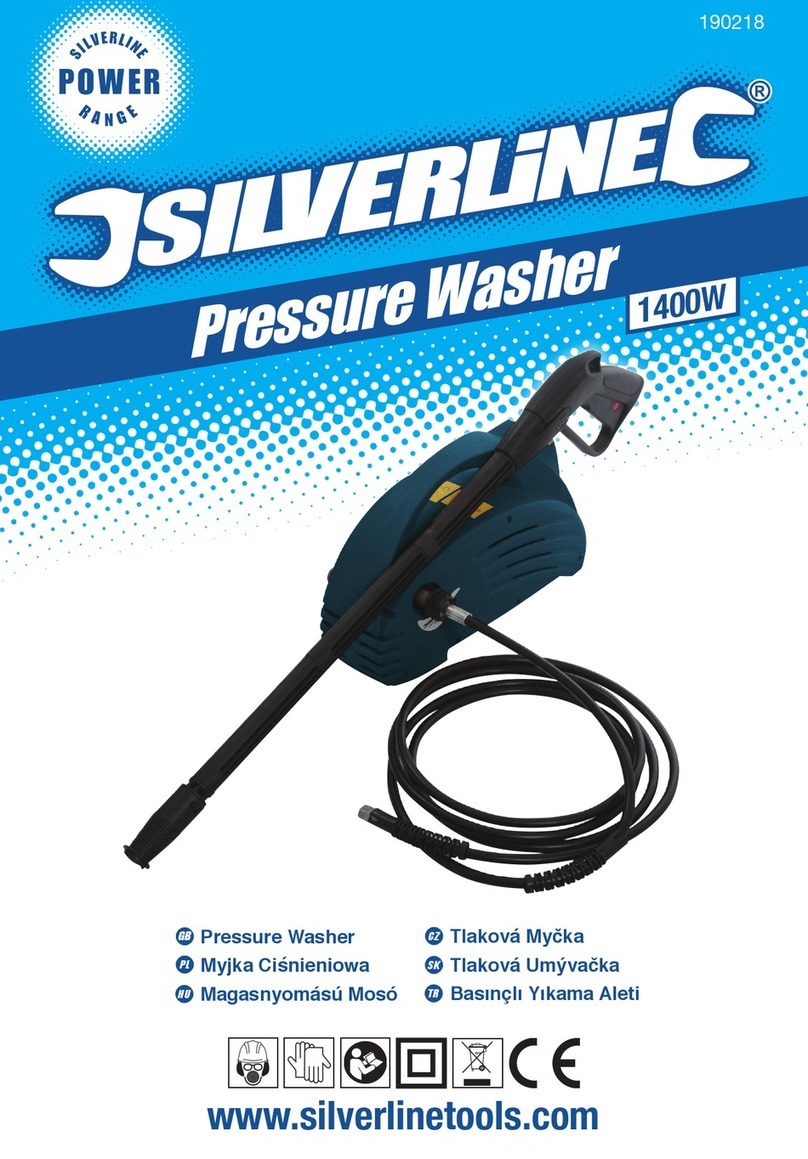
Silverline
Silverline 1400W Pressure Washer User manual
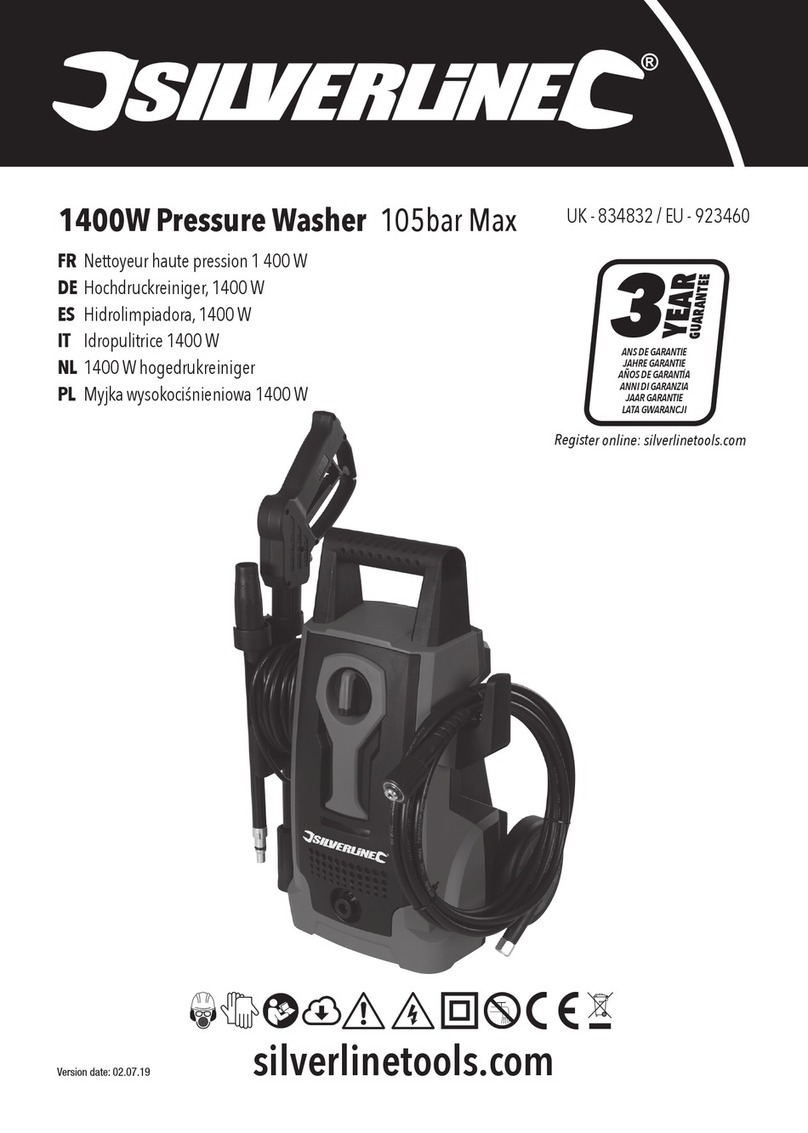
Silverline
Silverline 834832 User manual
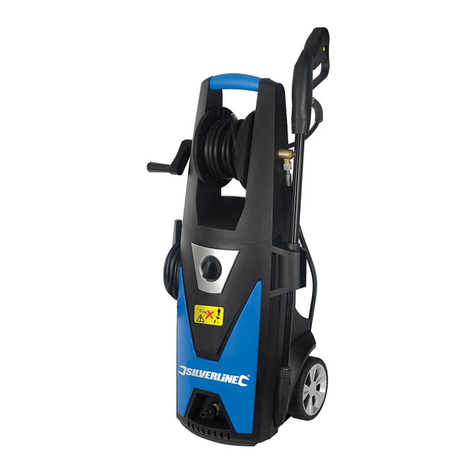
Silverline
Silverline 102377 User manual
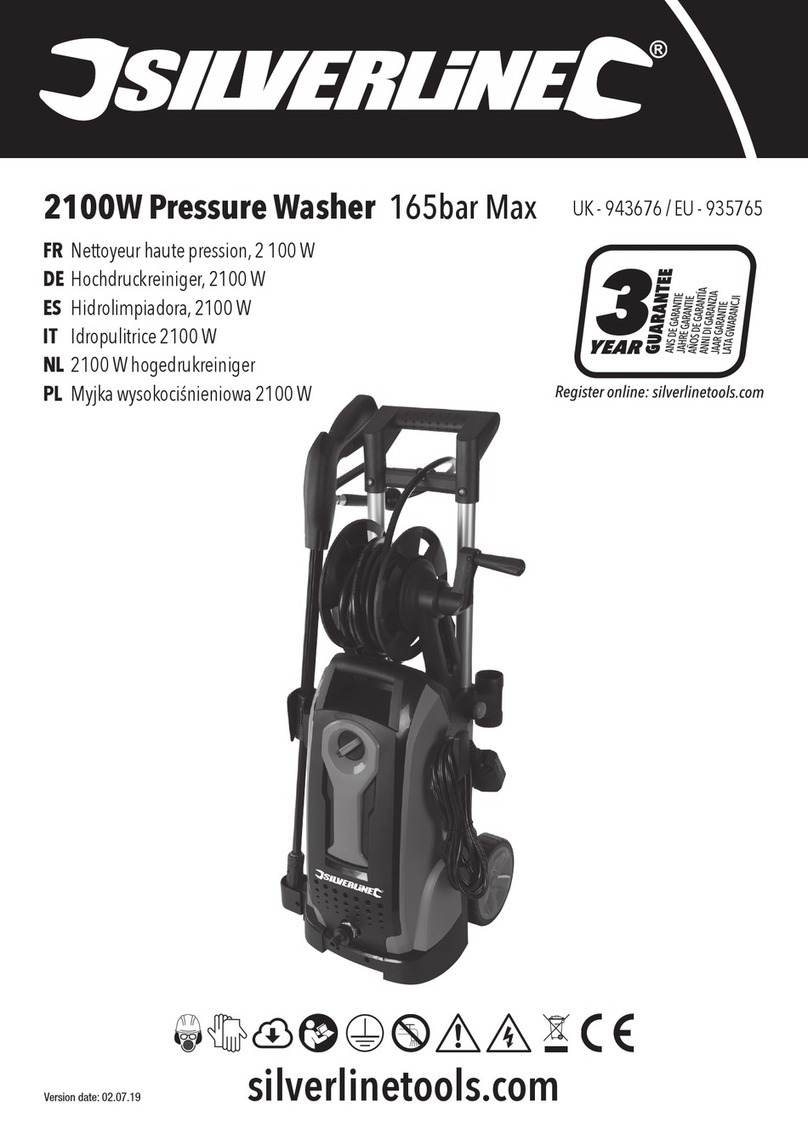
Silverline
Silverline 935765 User manual
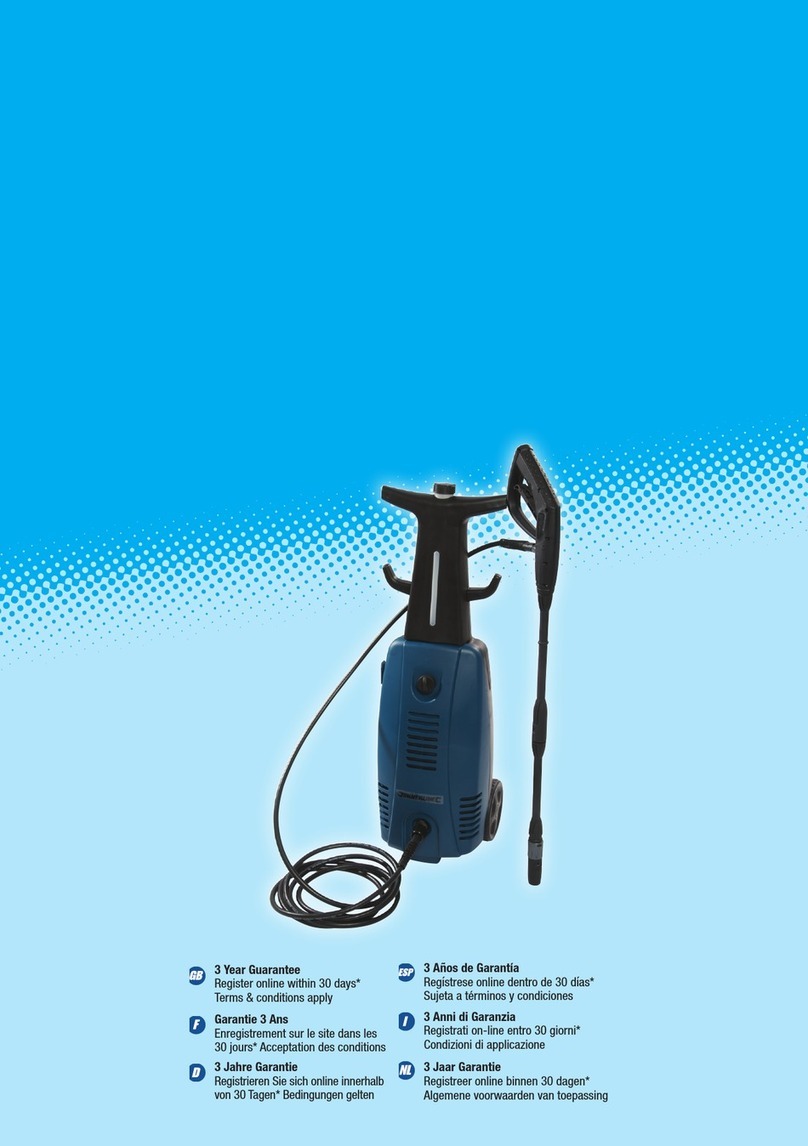
Silverline
Silverline 398920 User manual
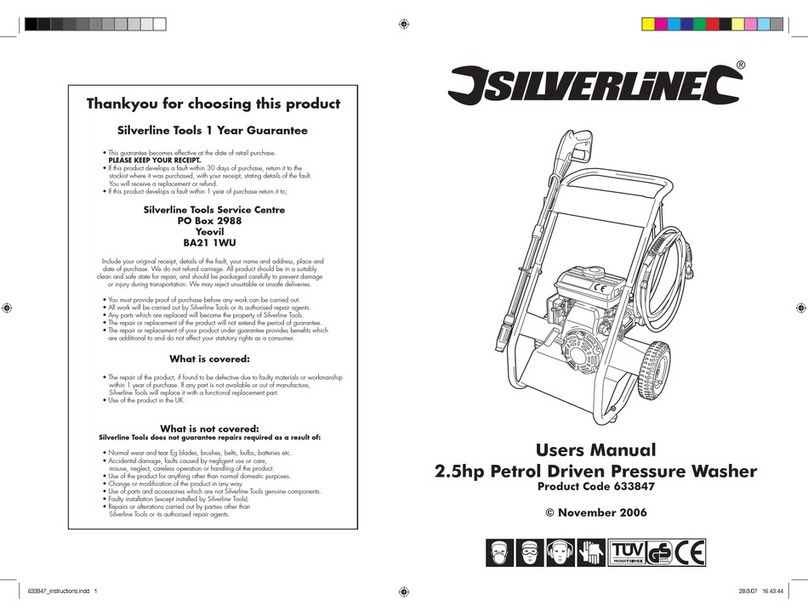
Silverline
Silverline 633847 User manual

Silverline
Silverline 633847 User manual

Silverline
Silverline 1400W Pressure Washer User manual
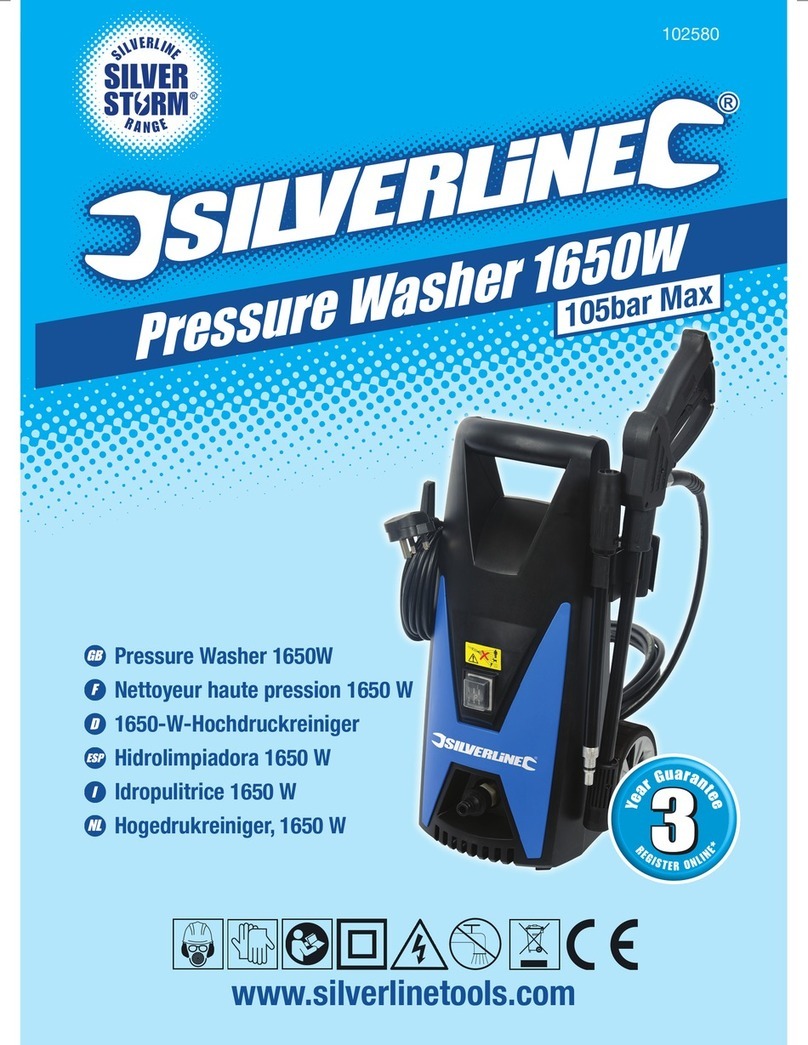
Silverline
Silverline 102580 User manual

